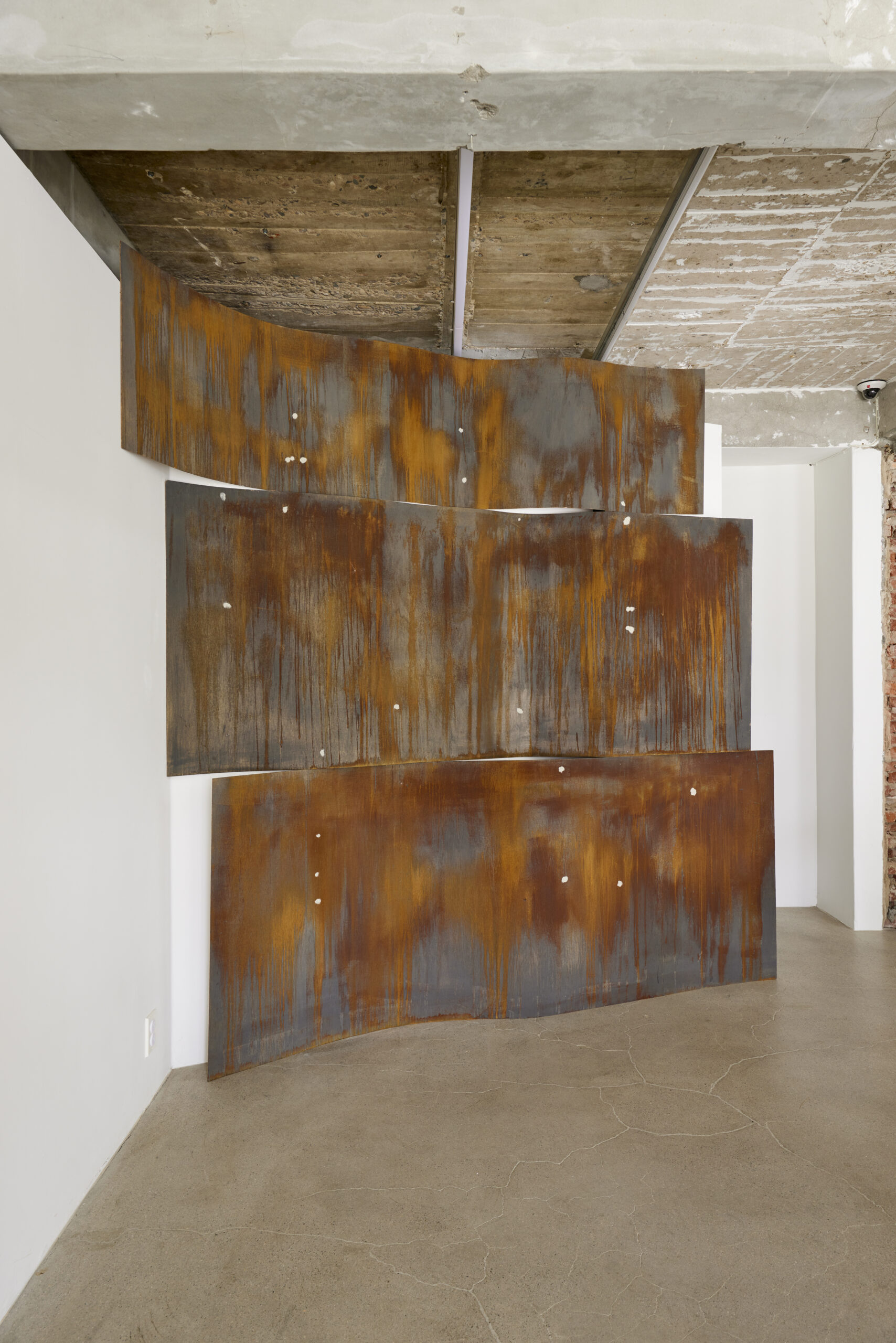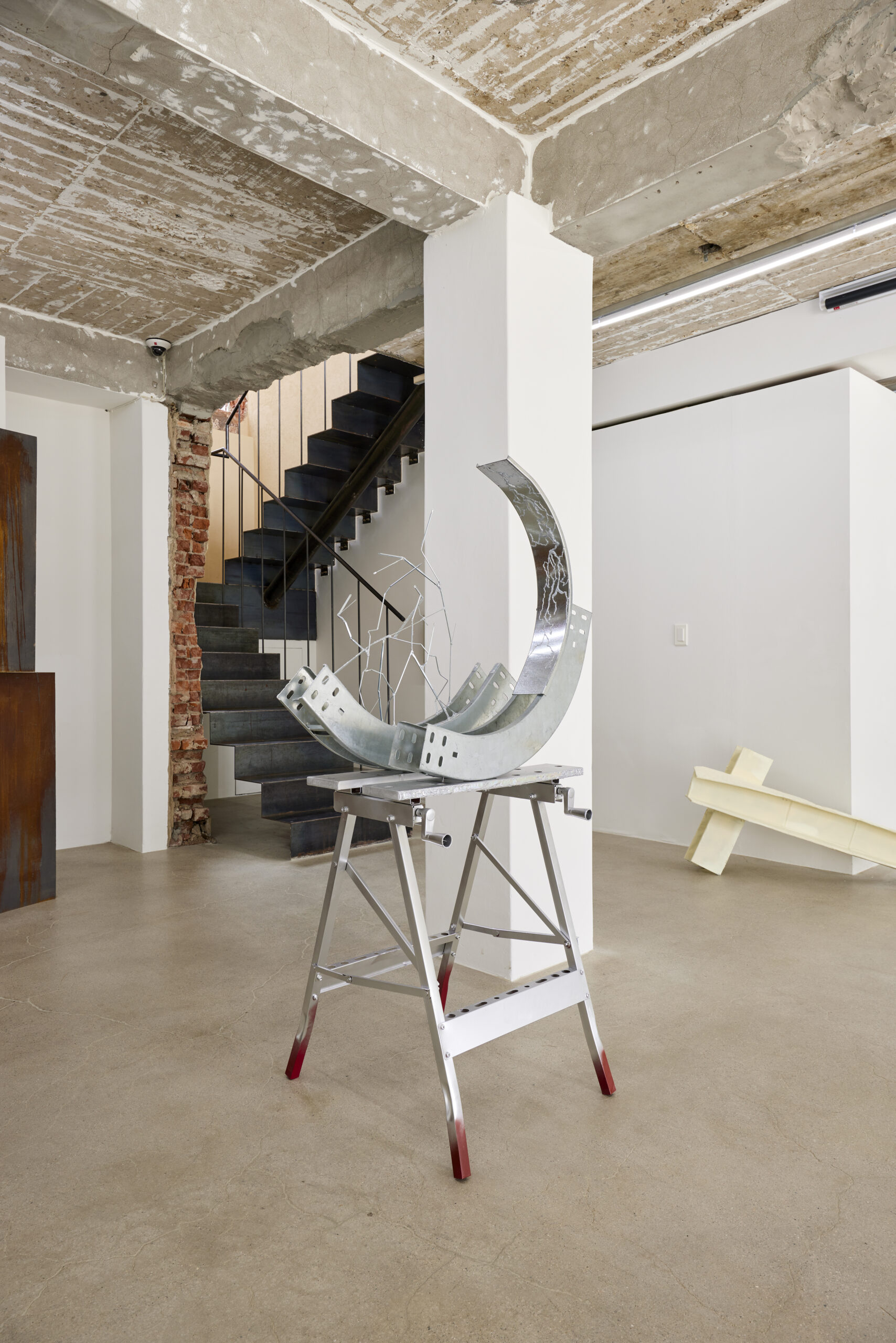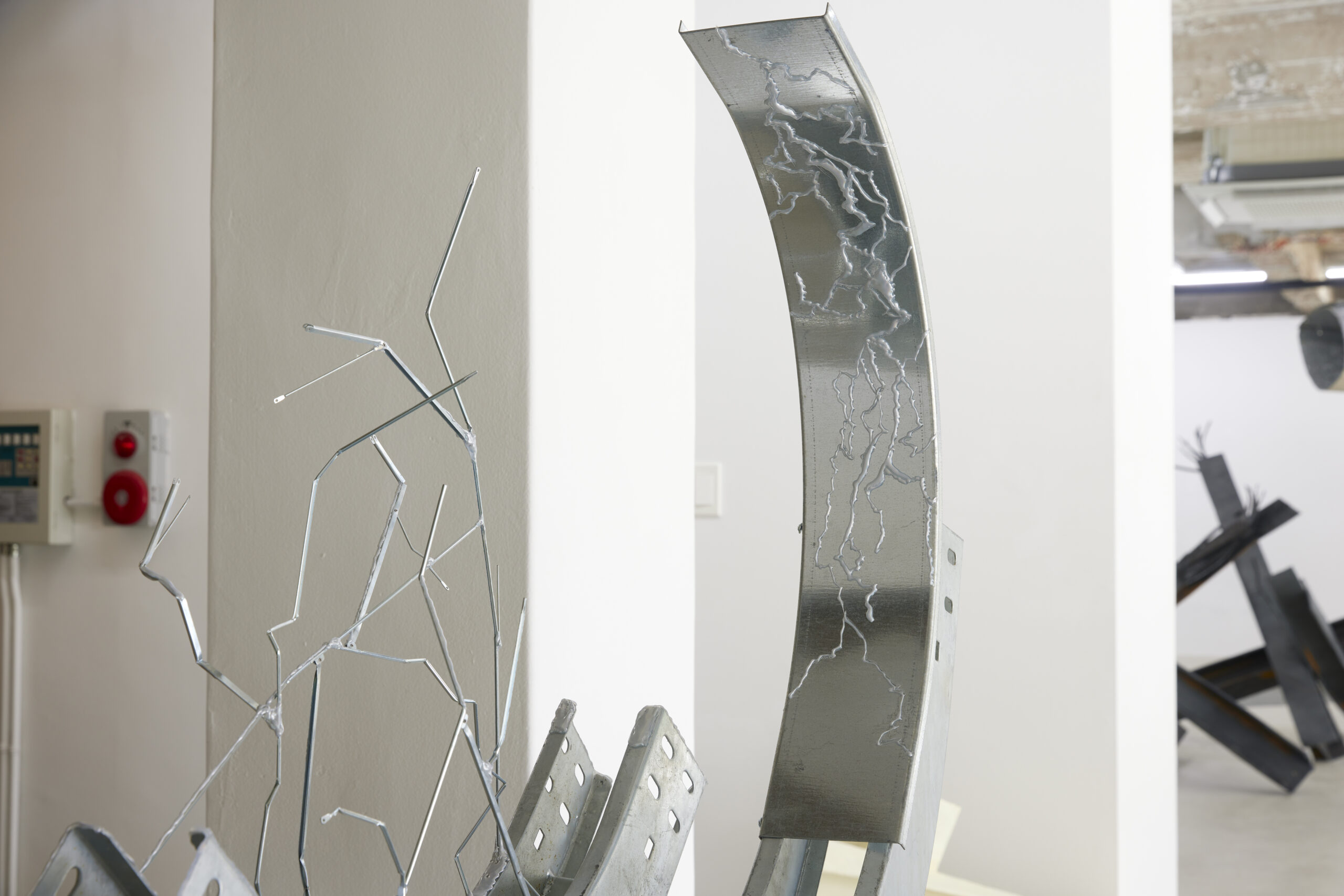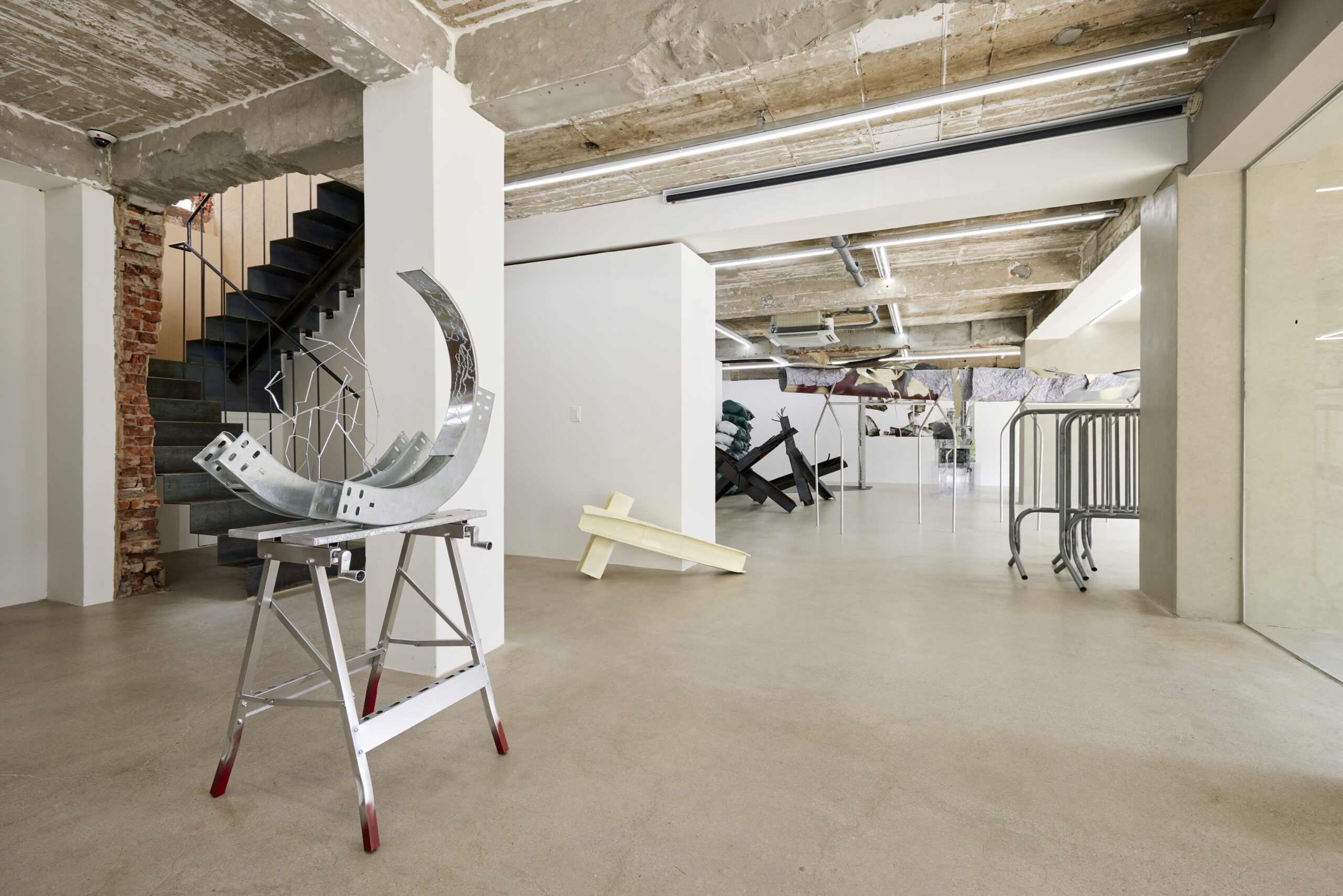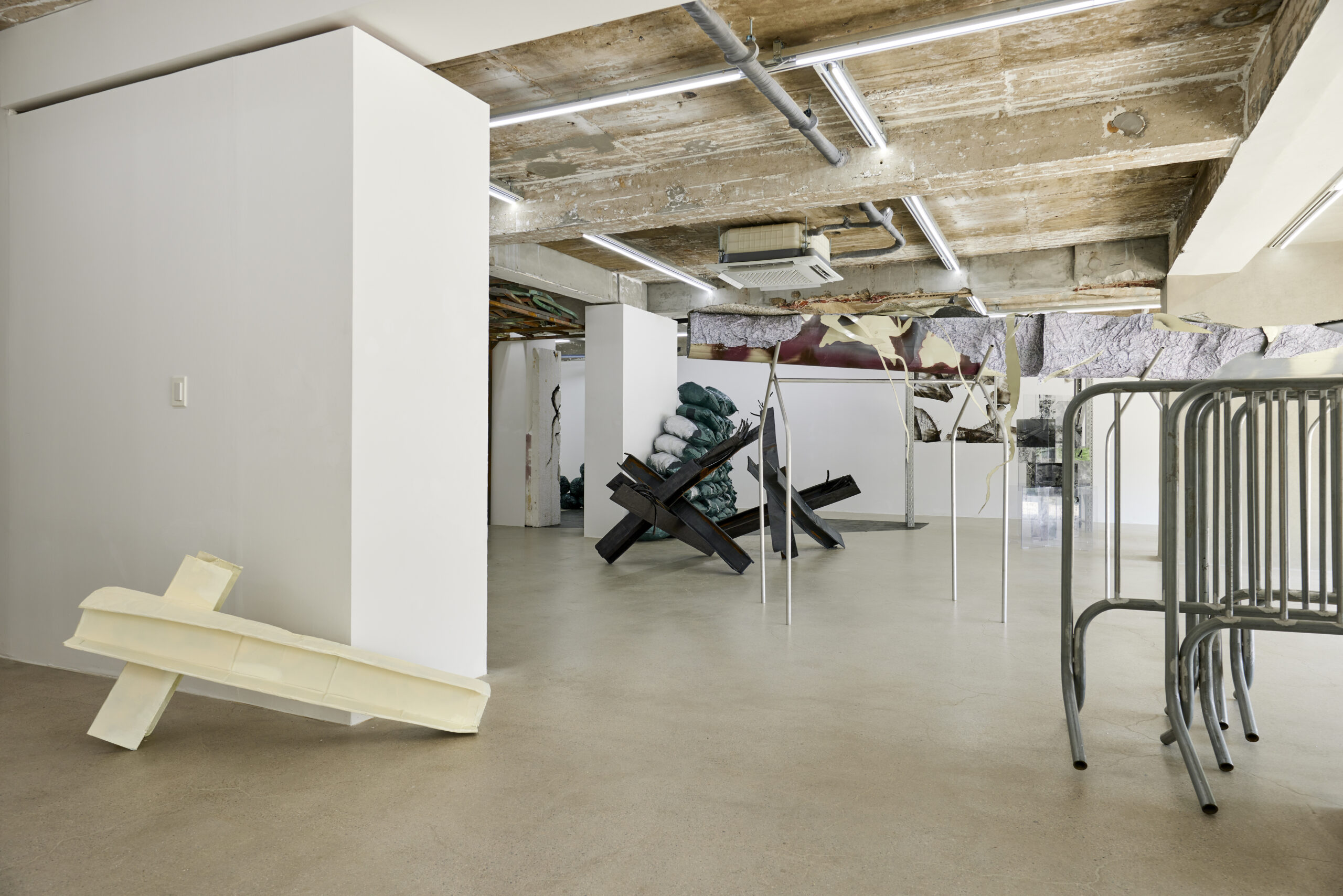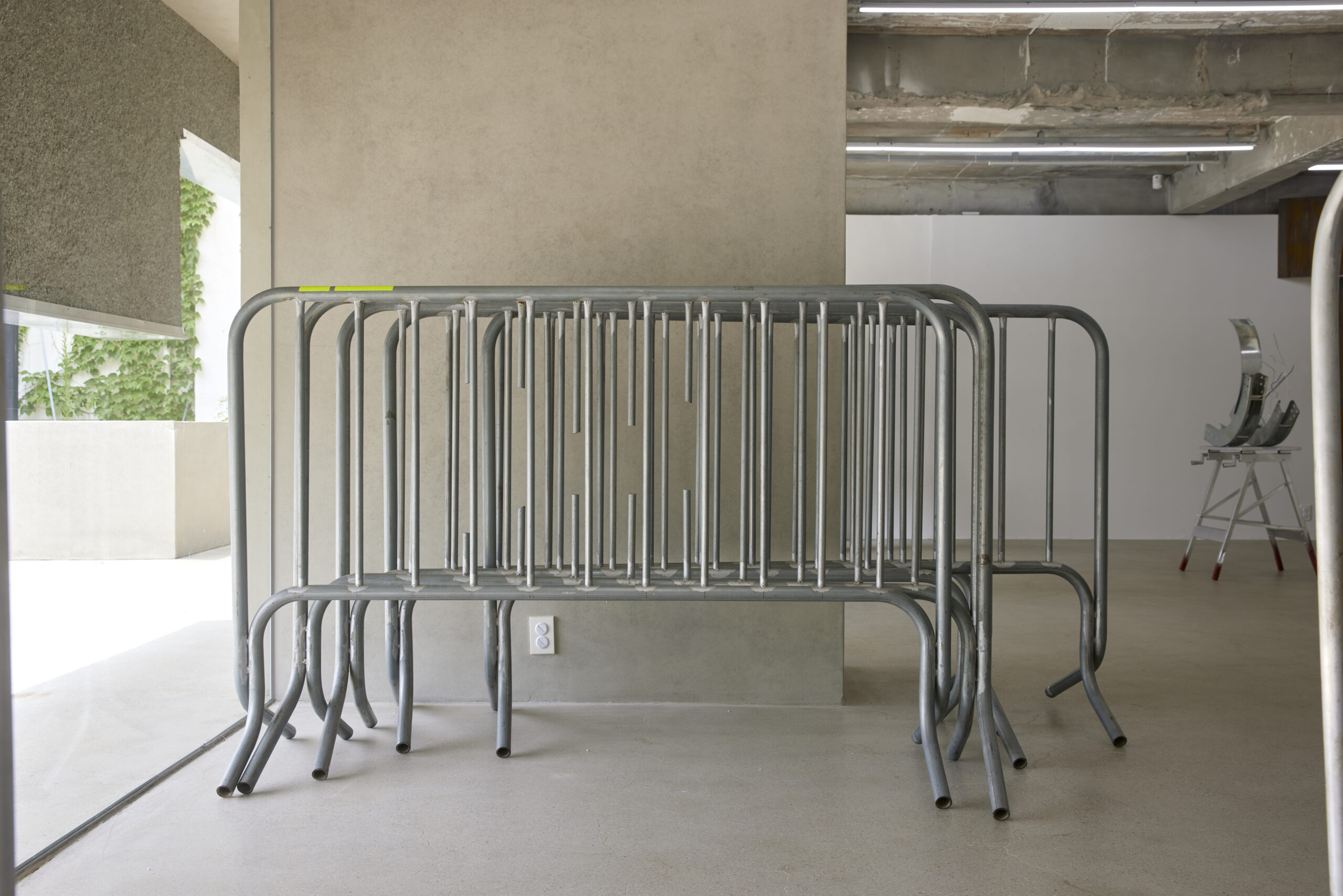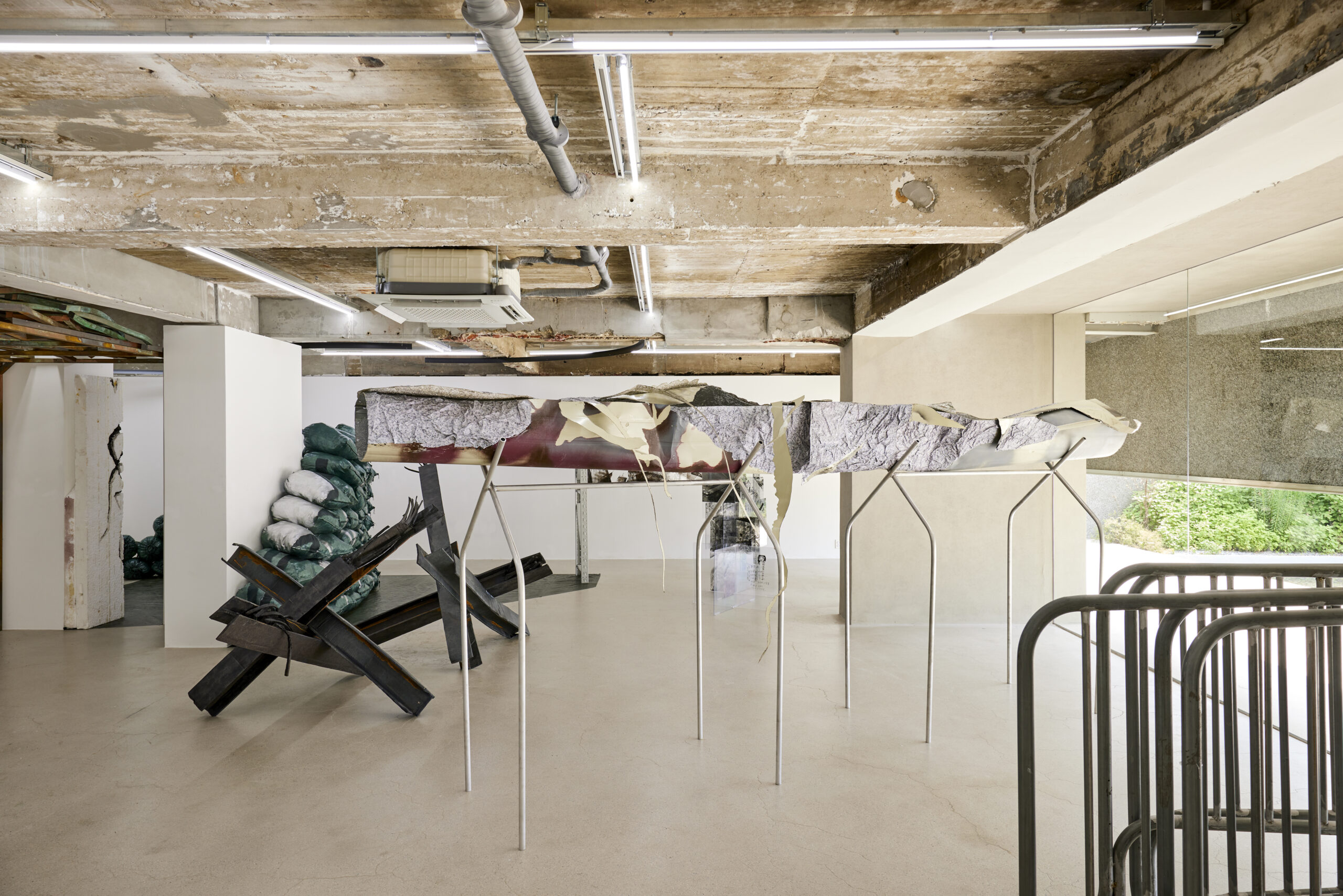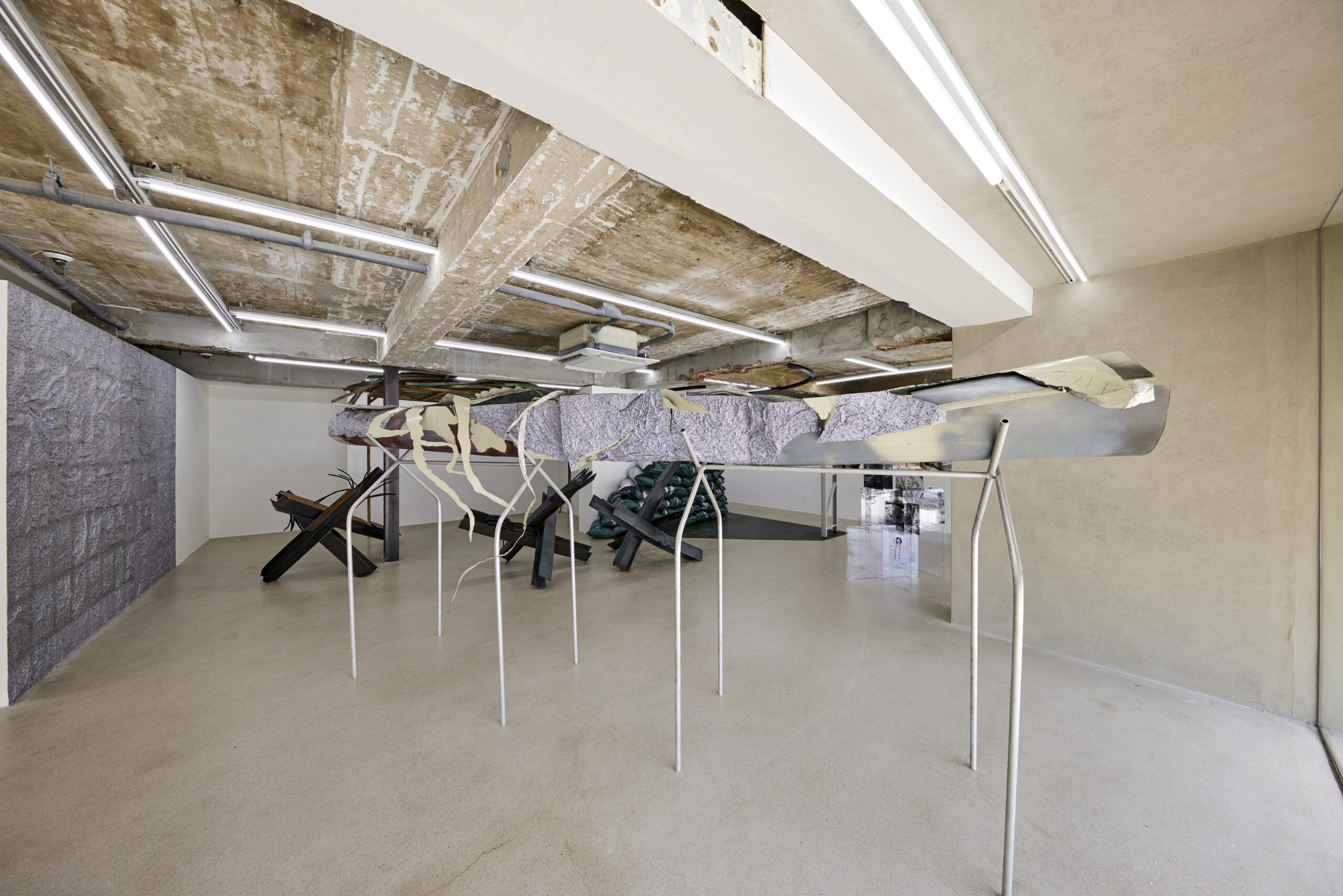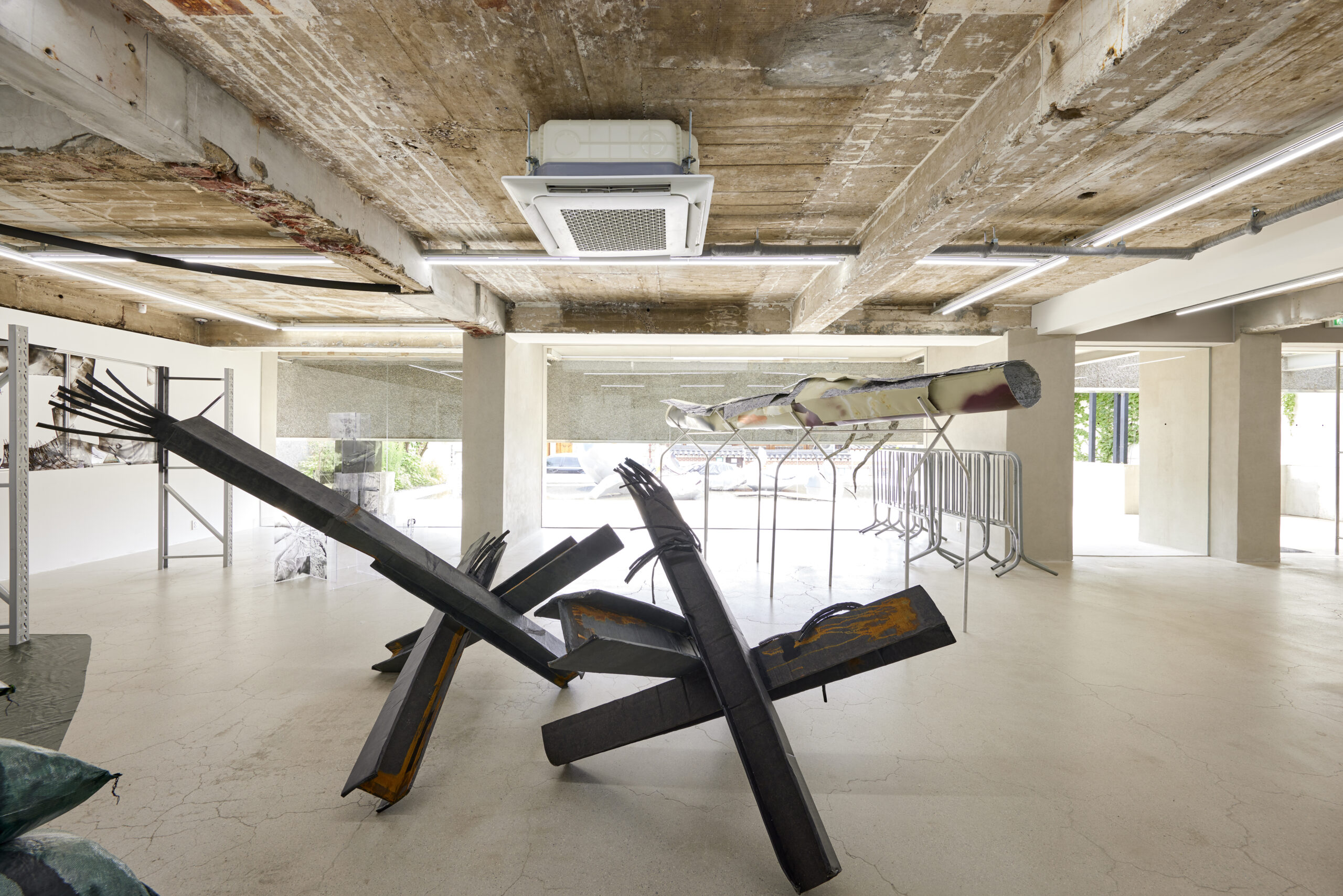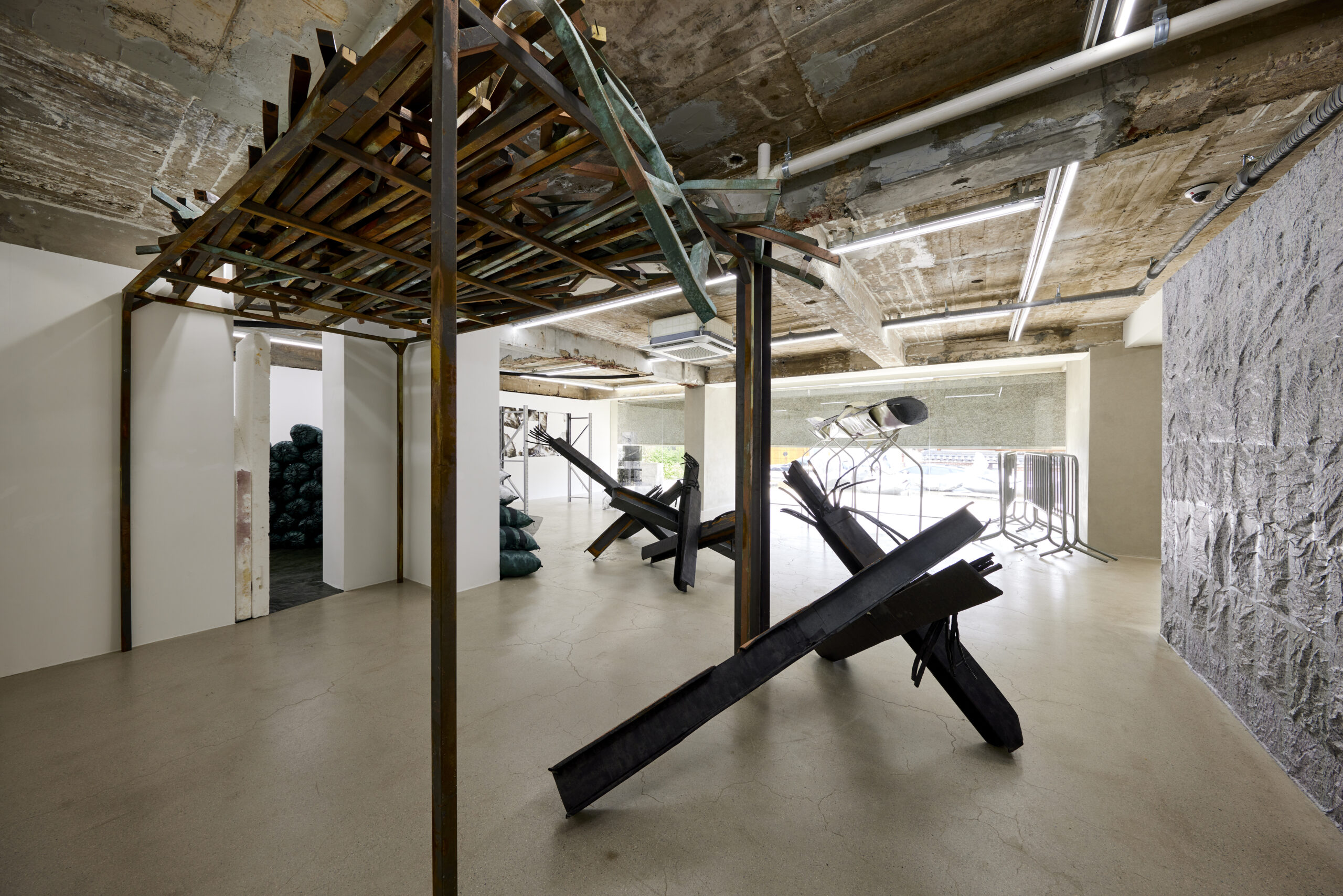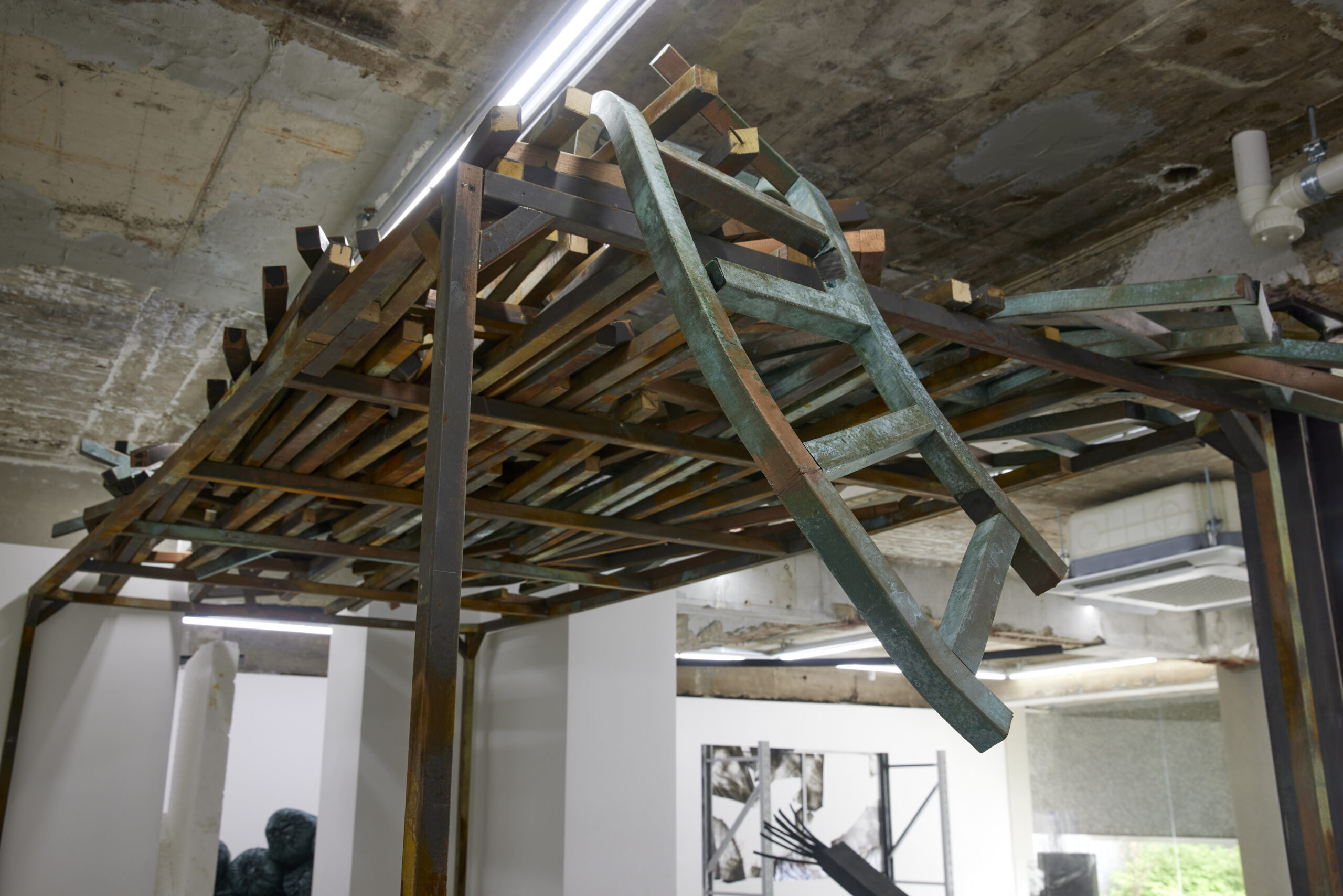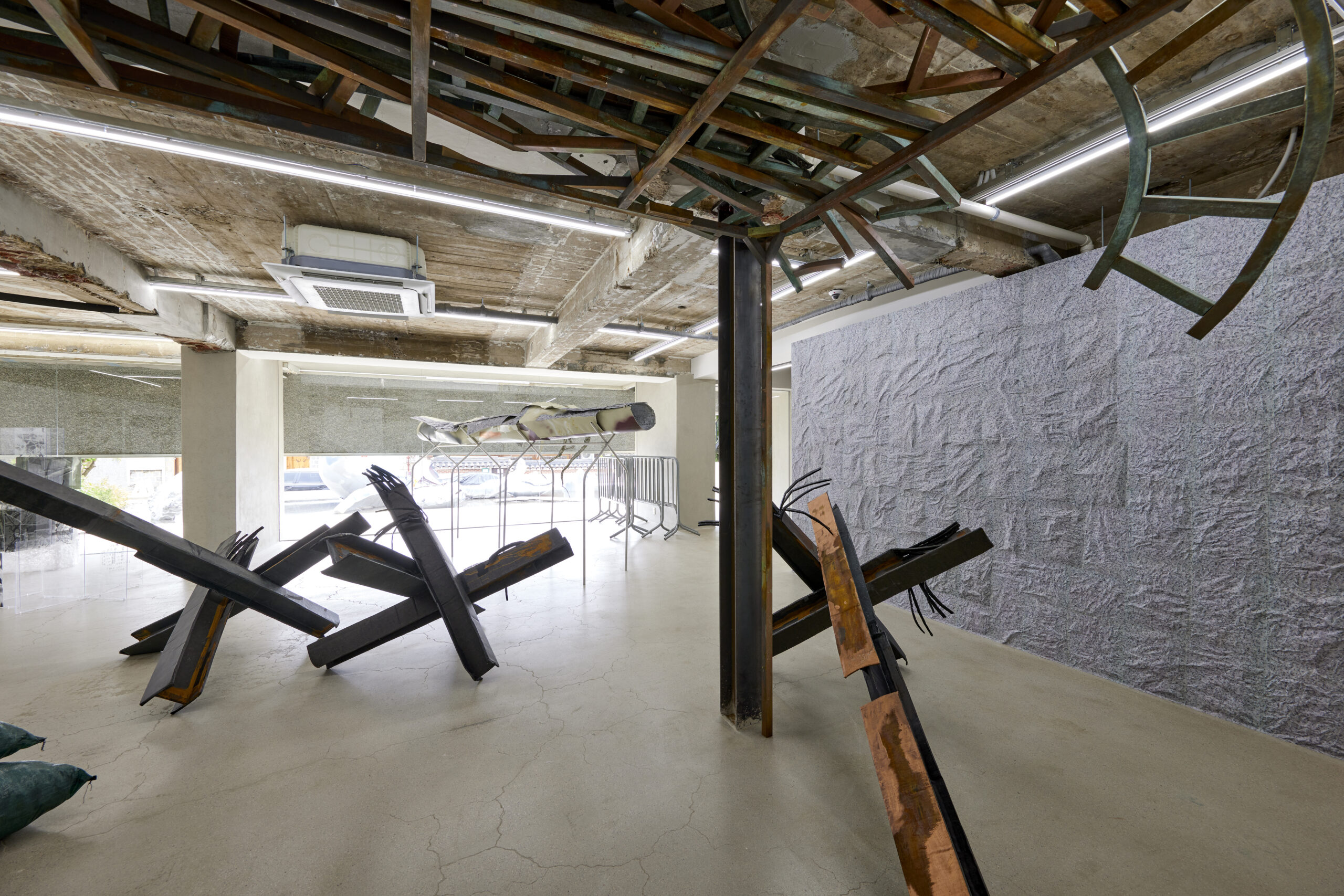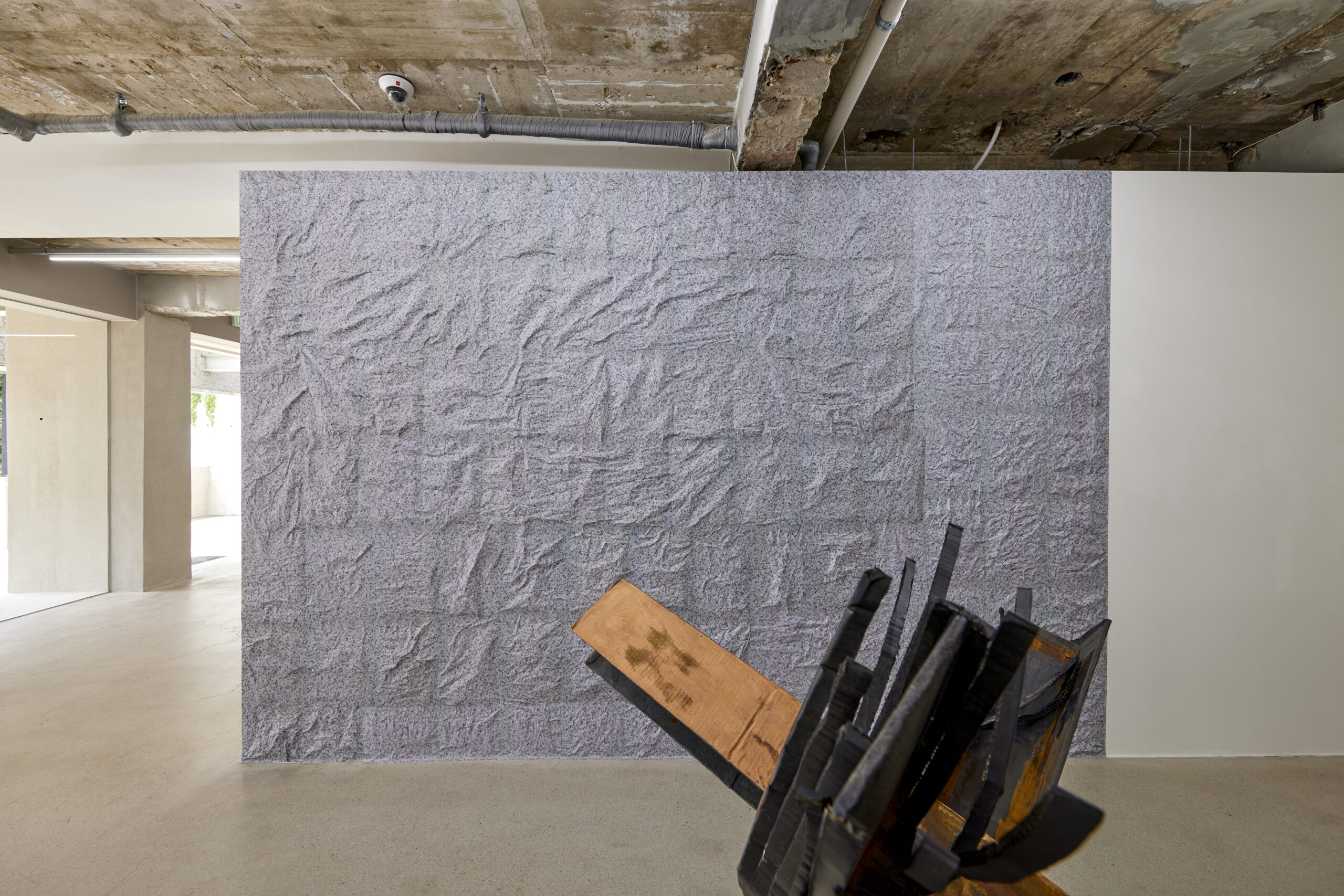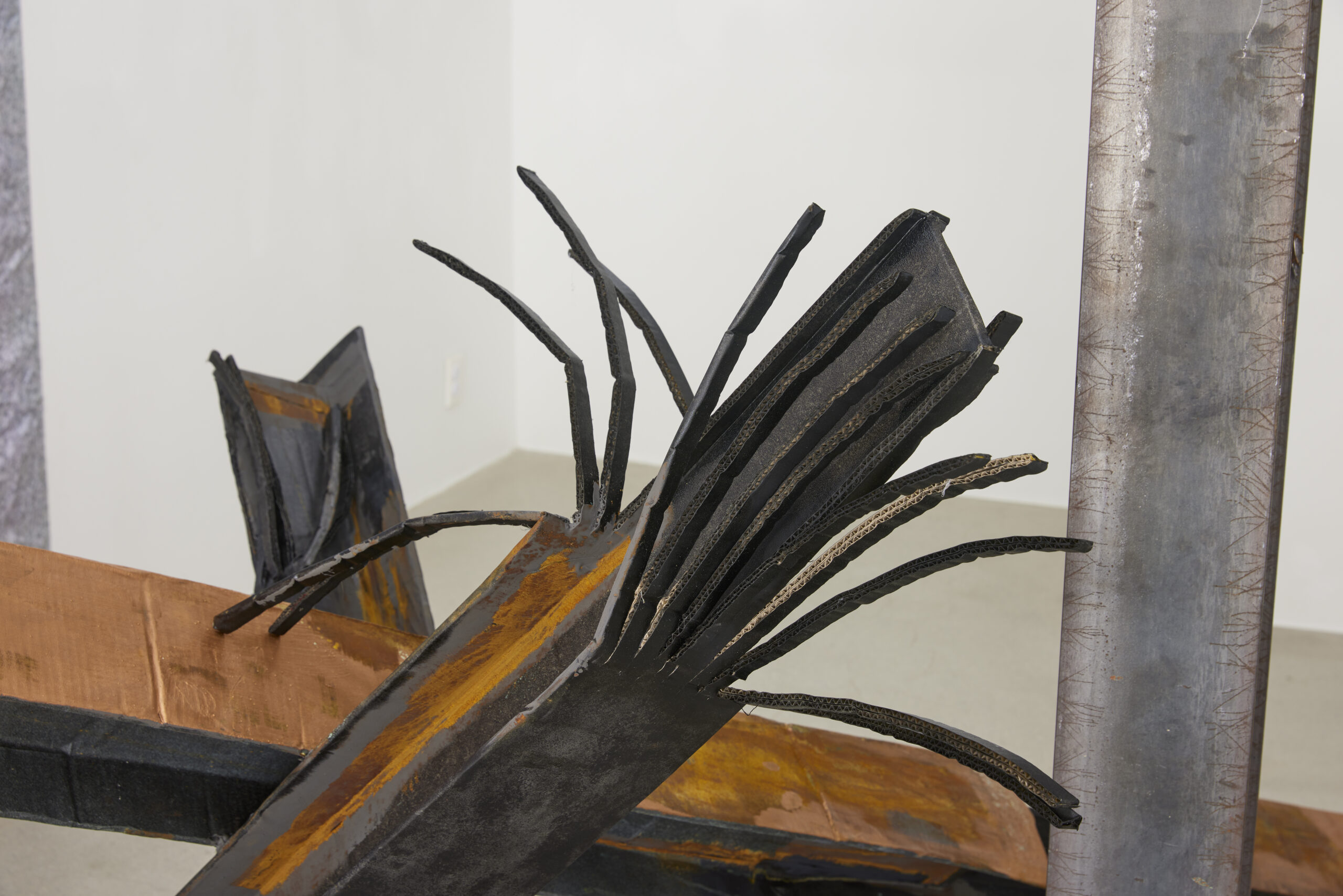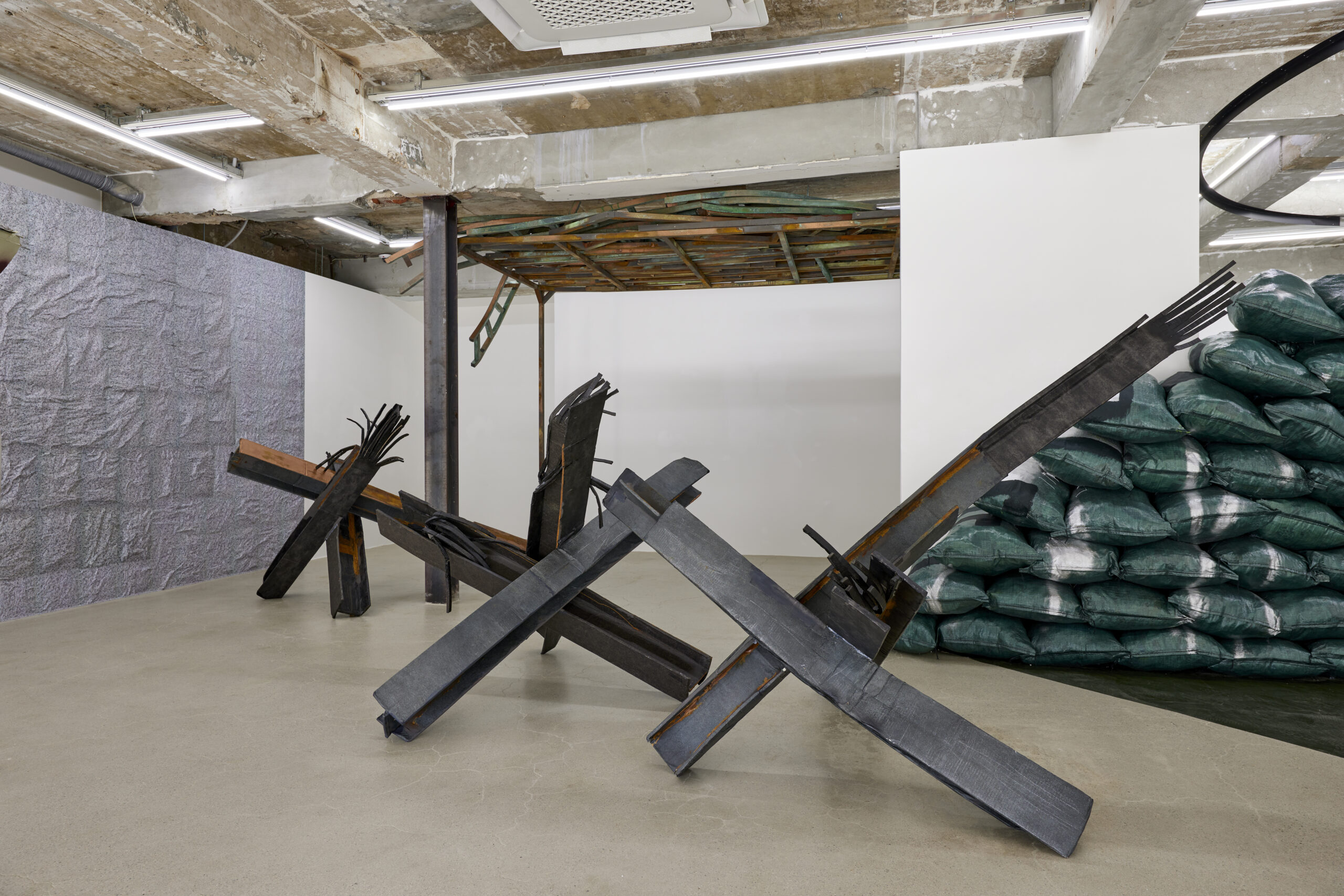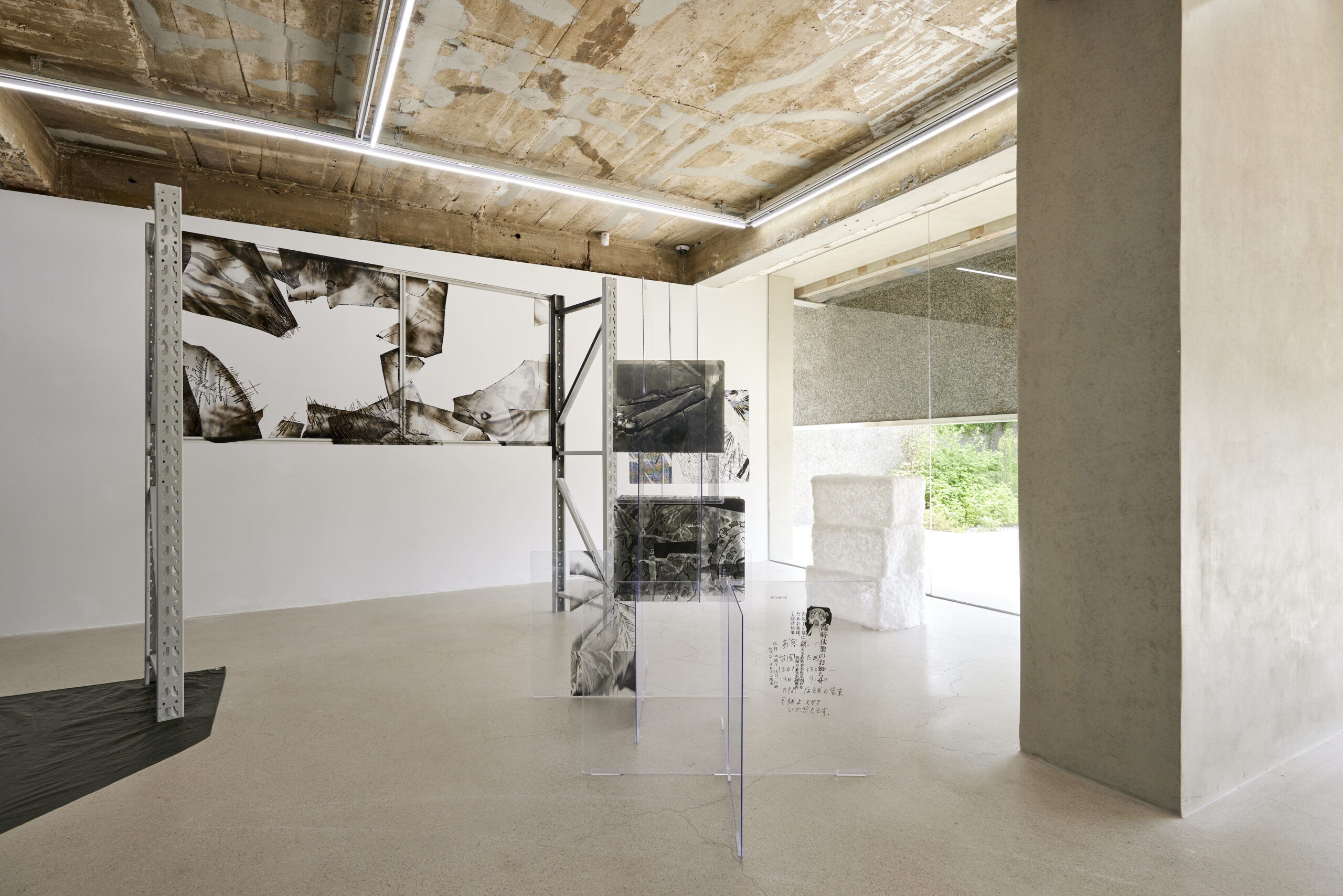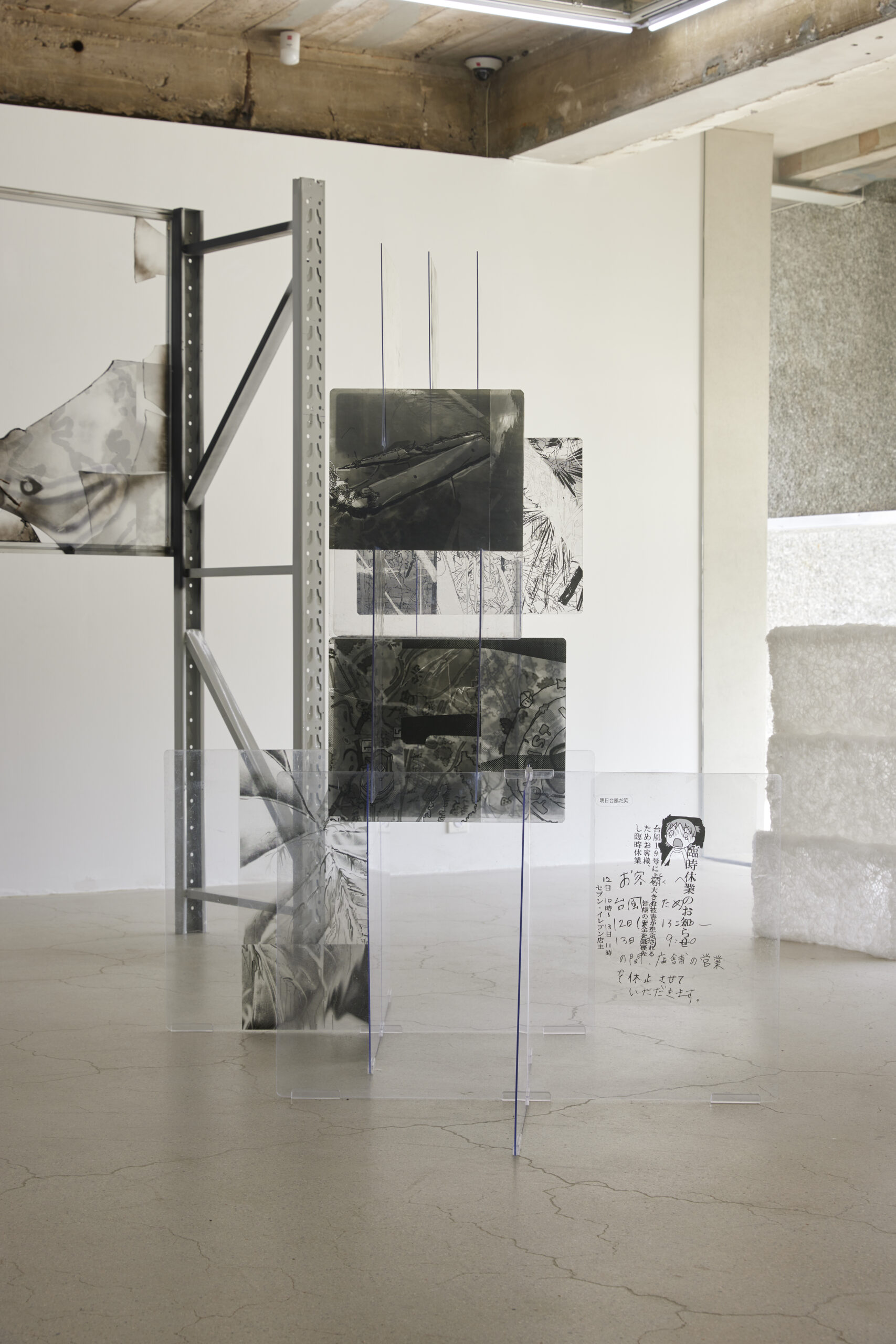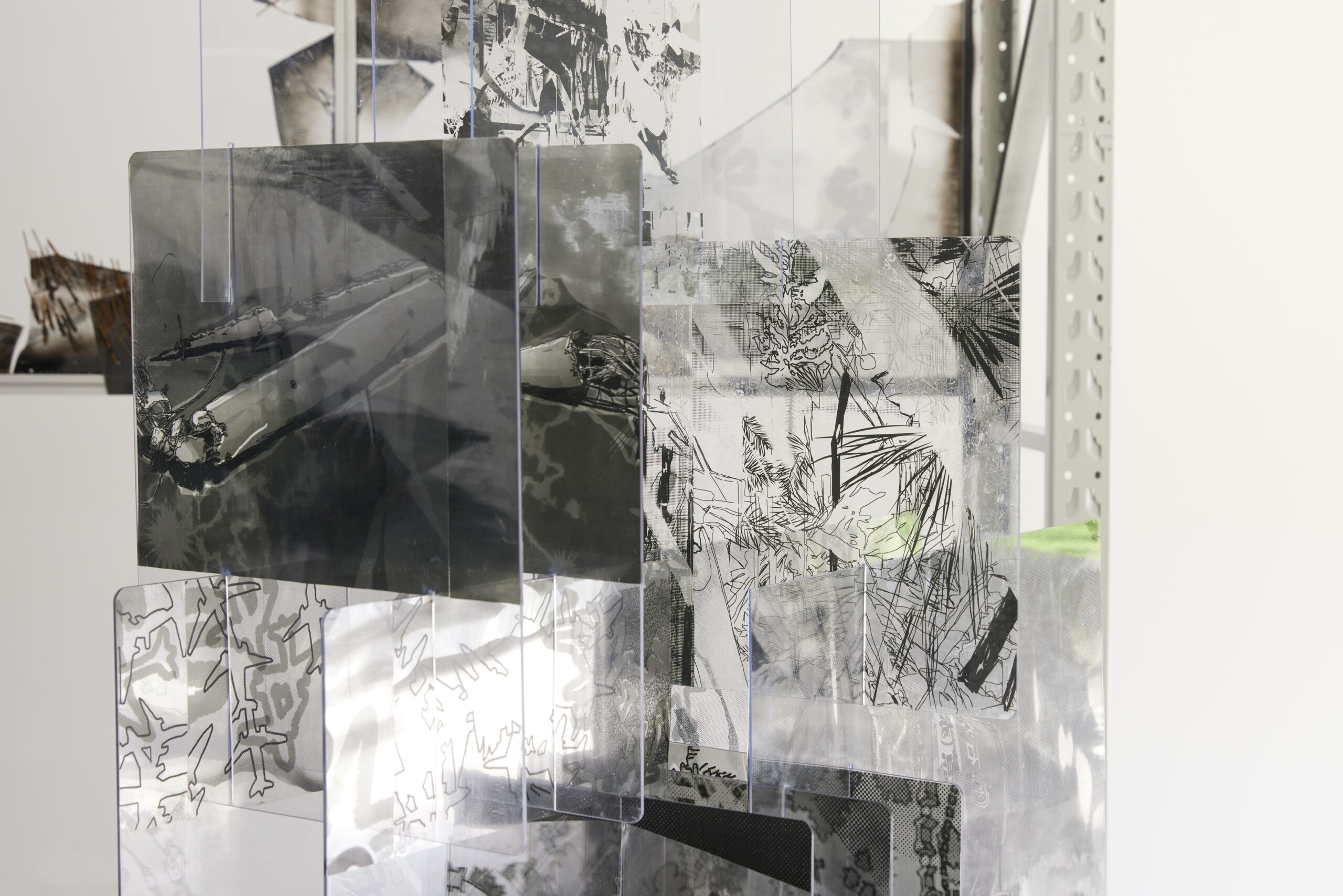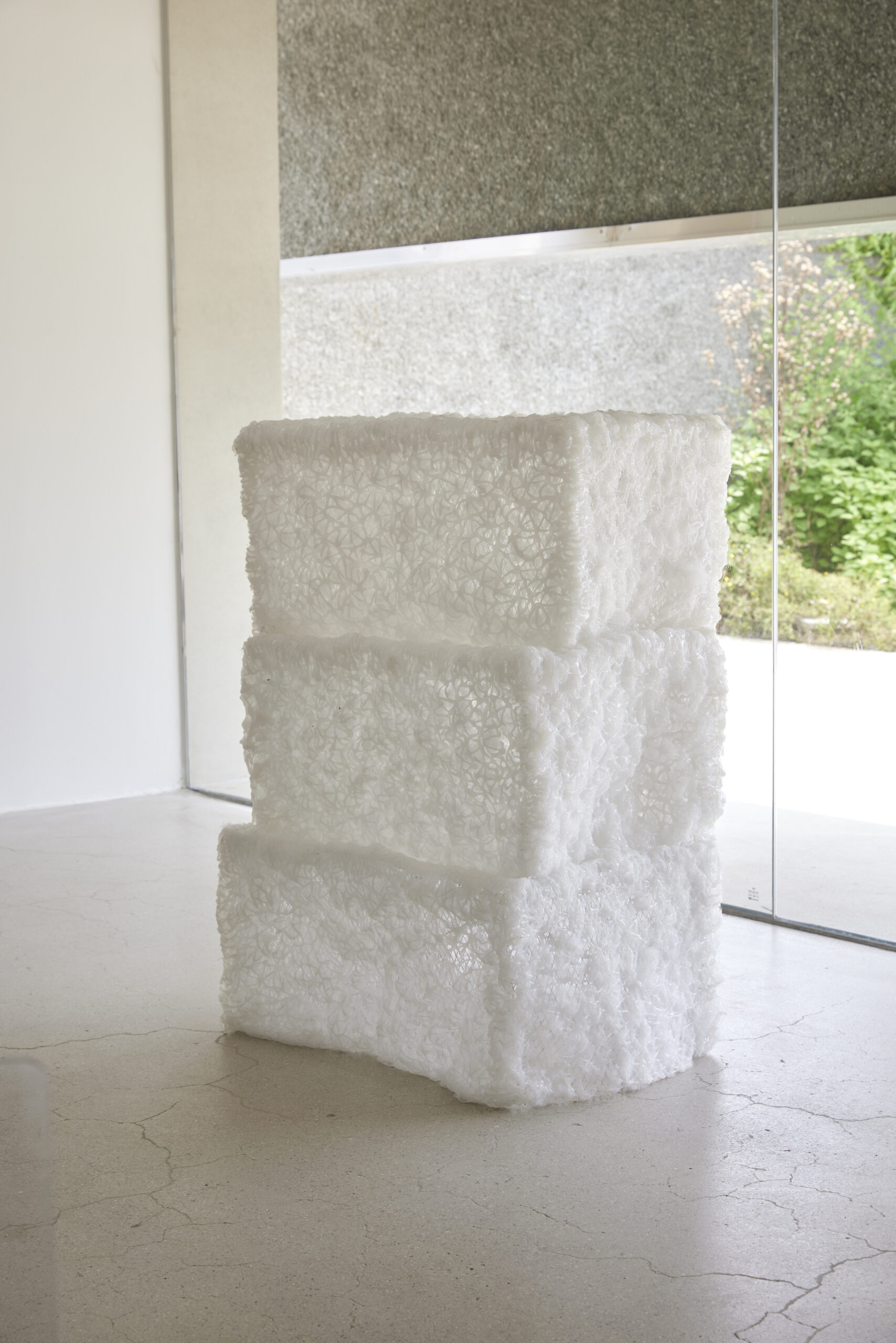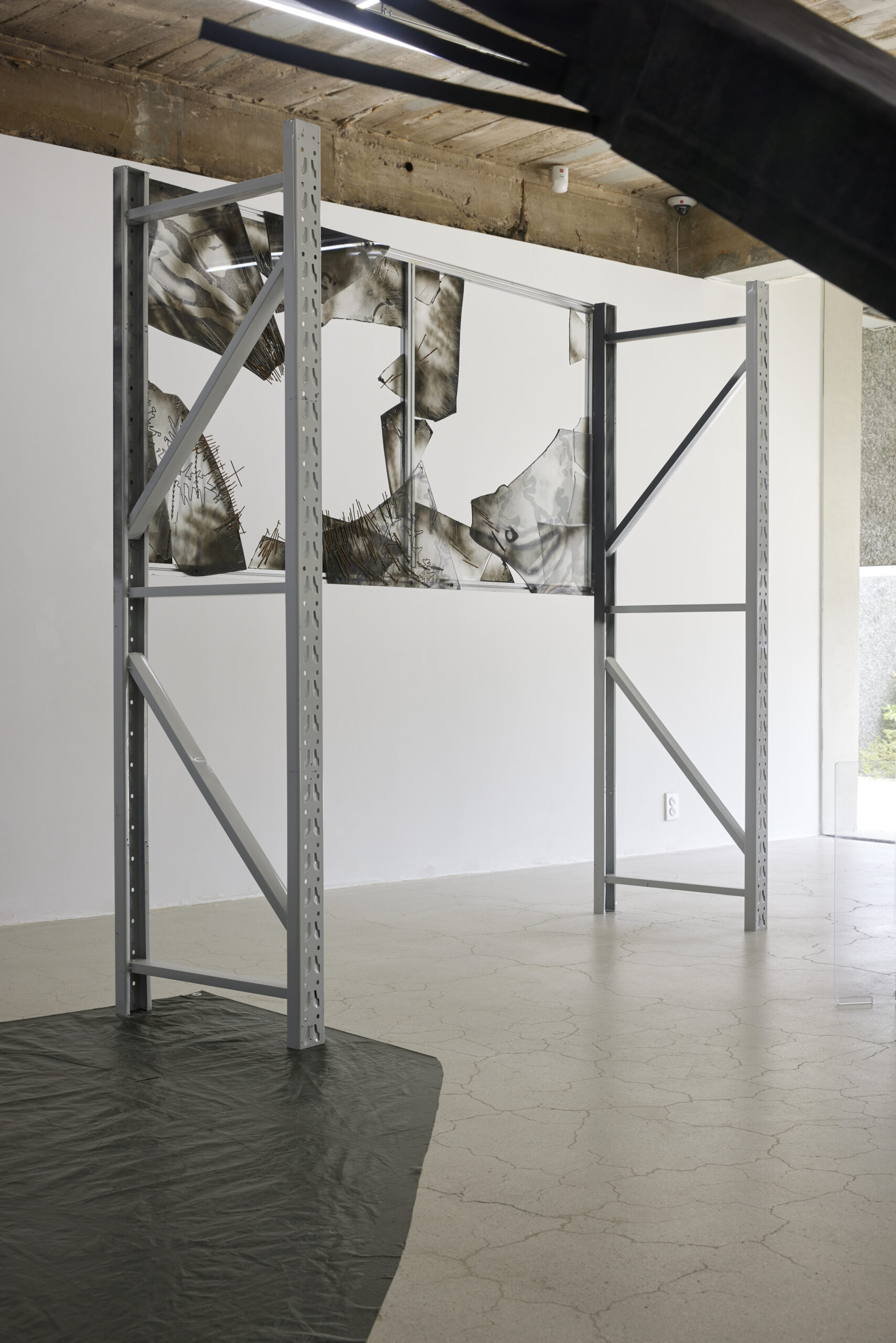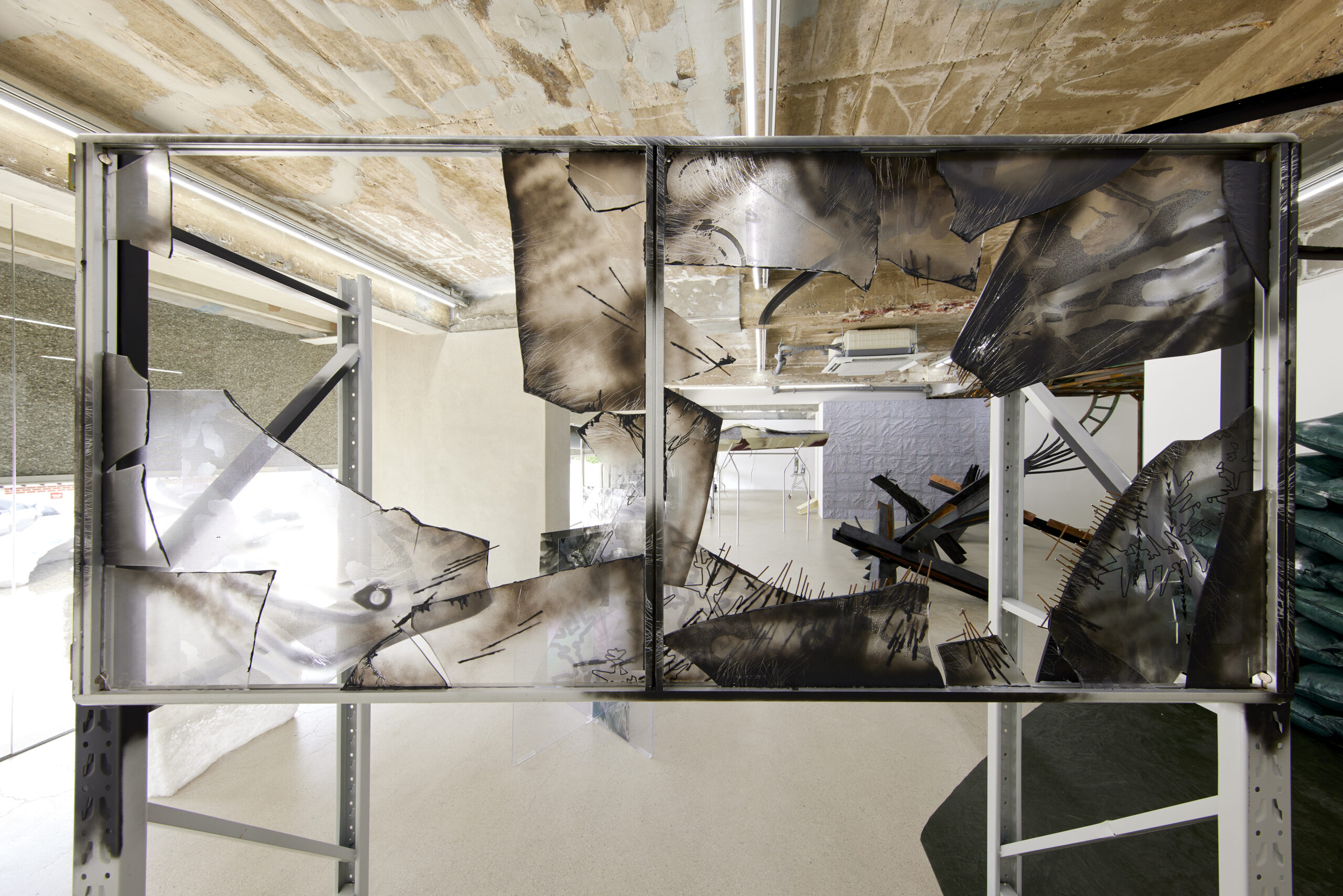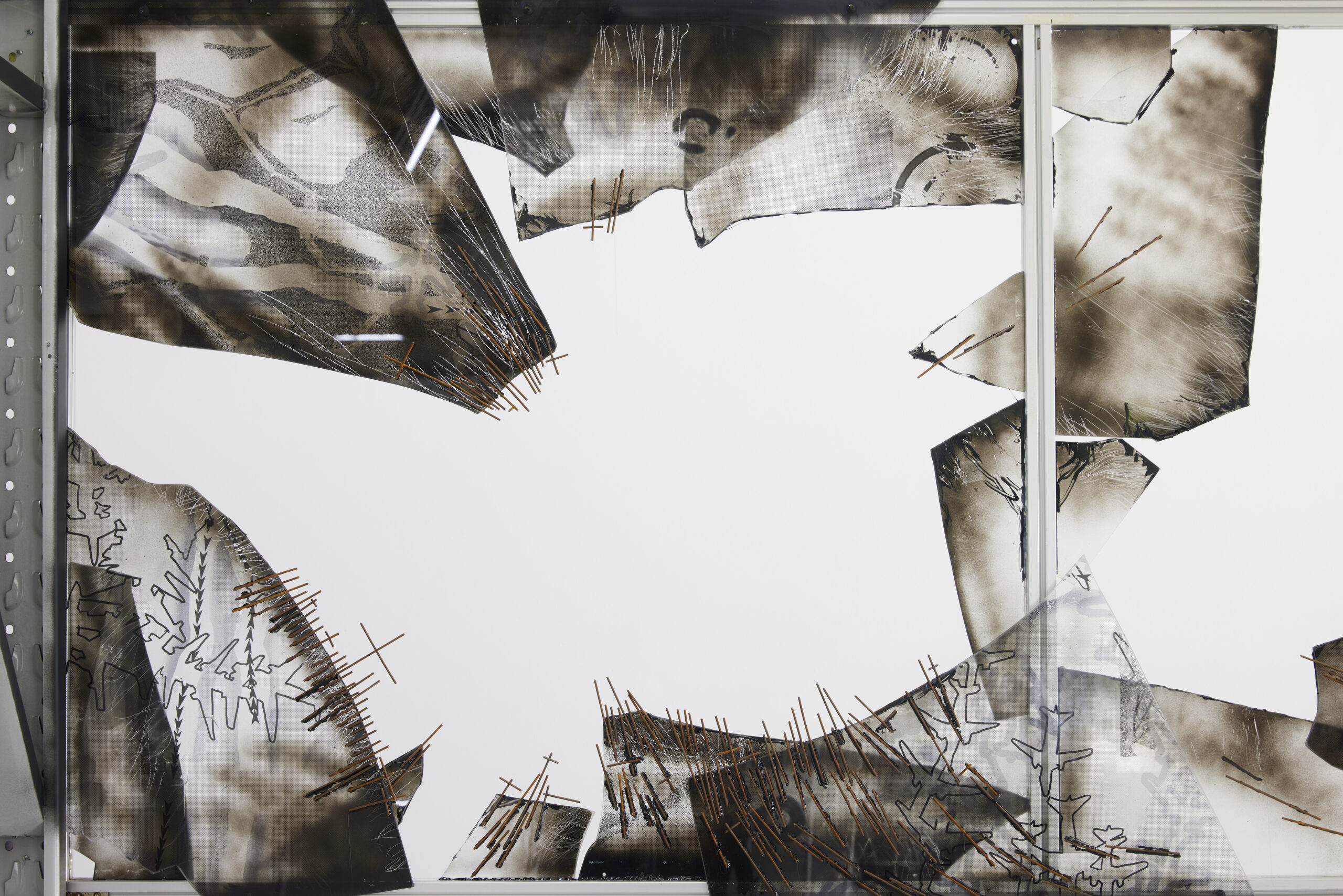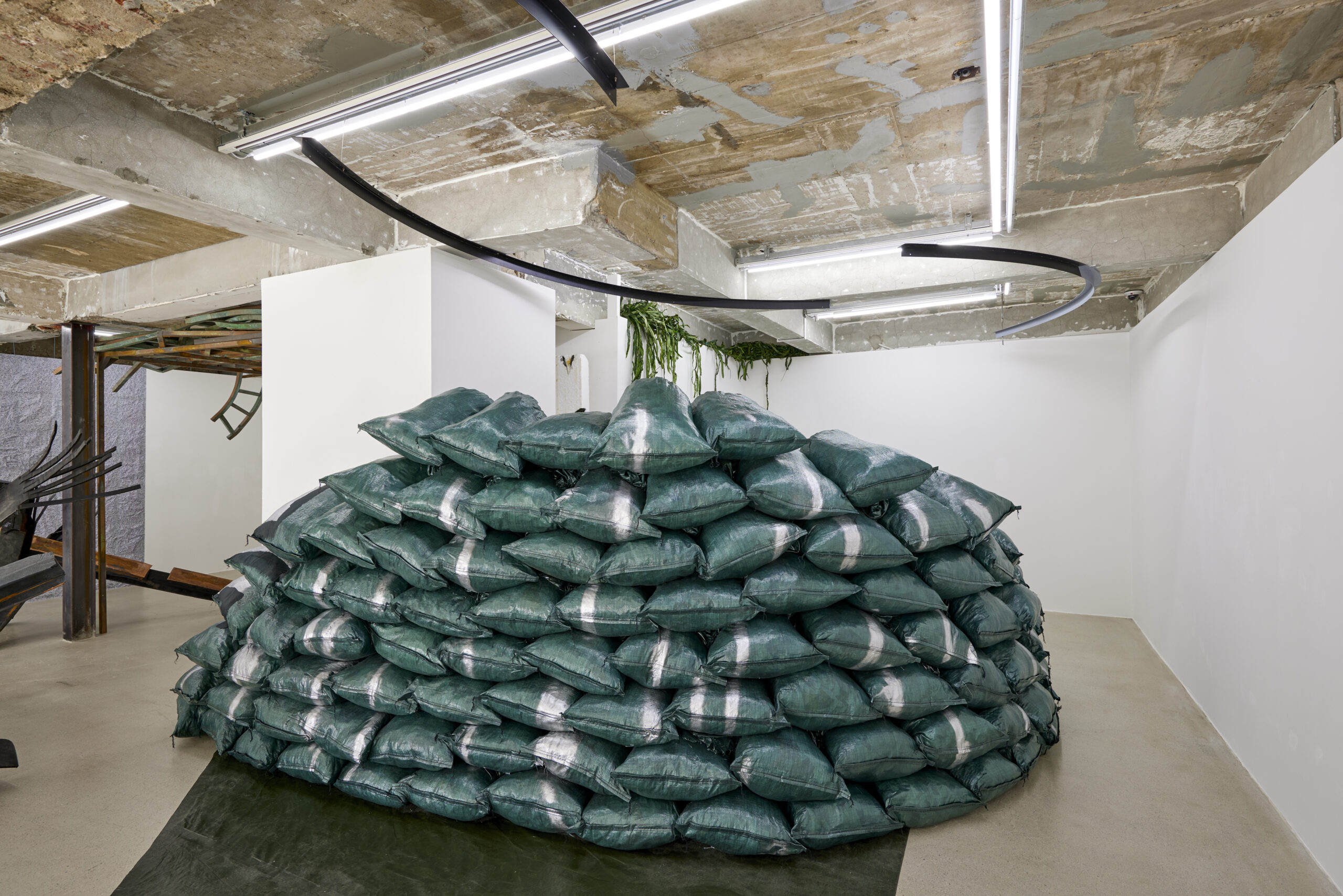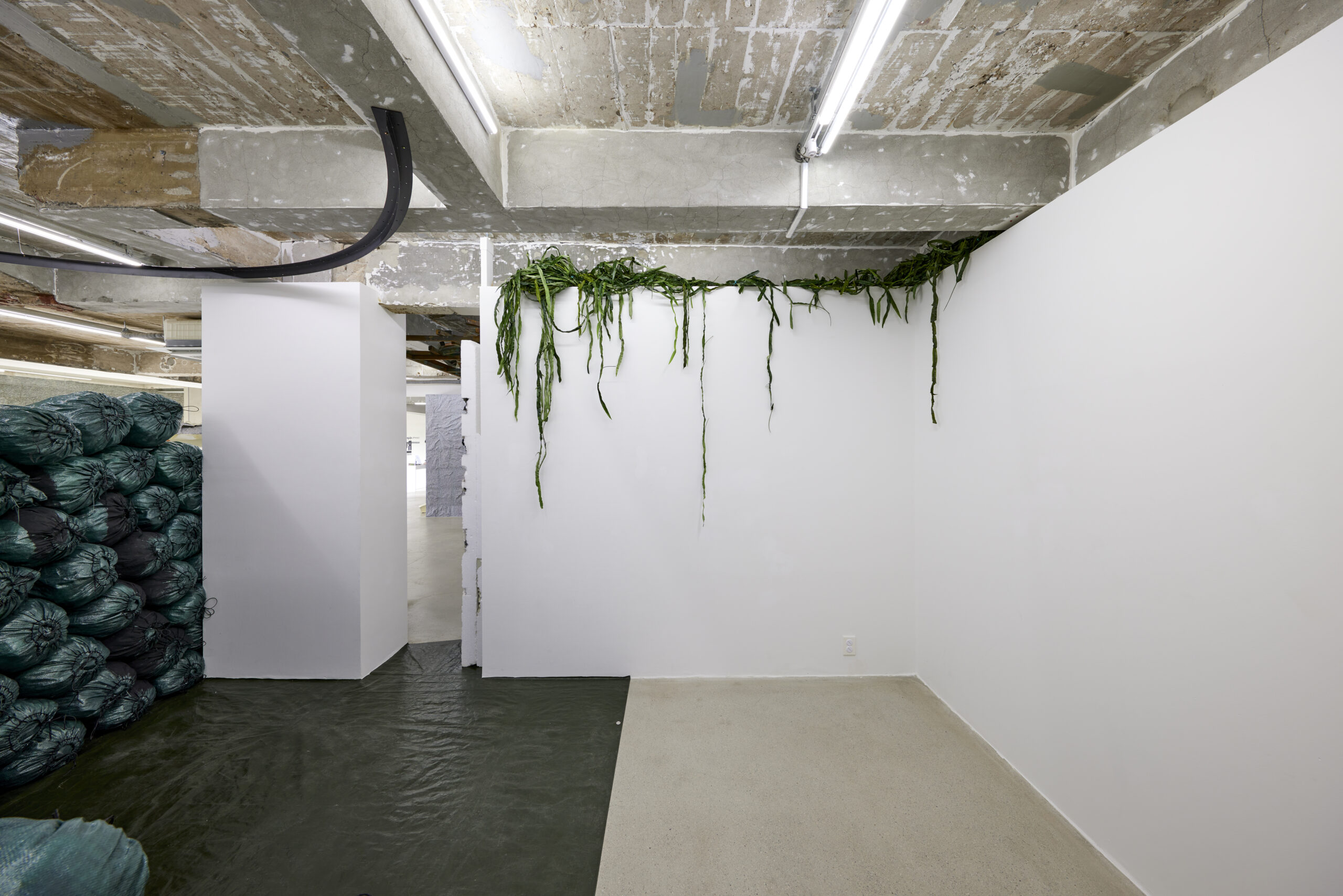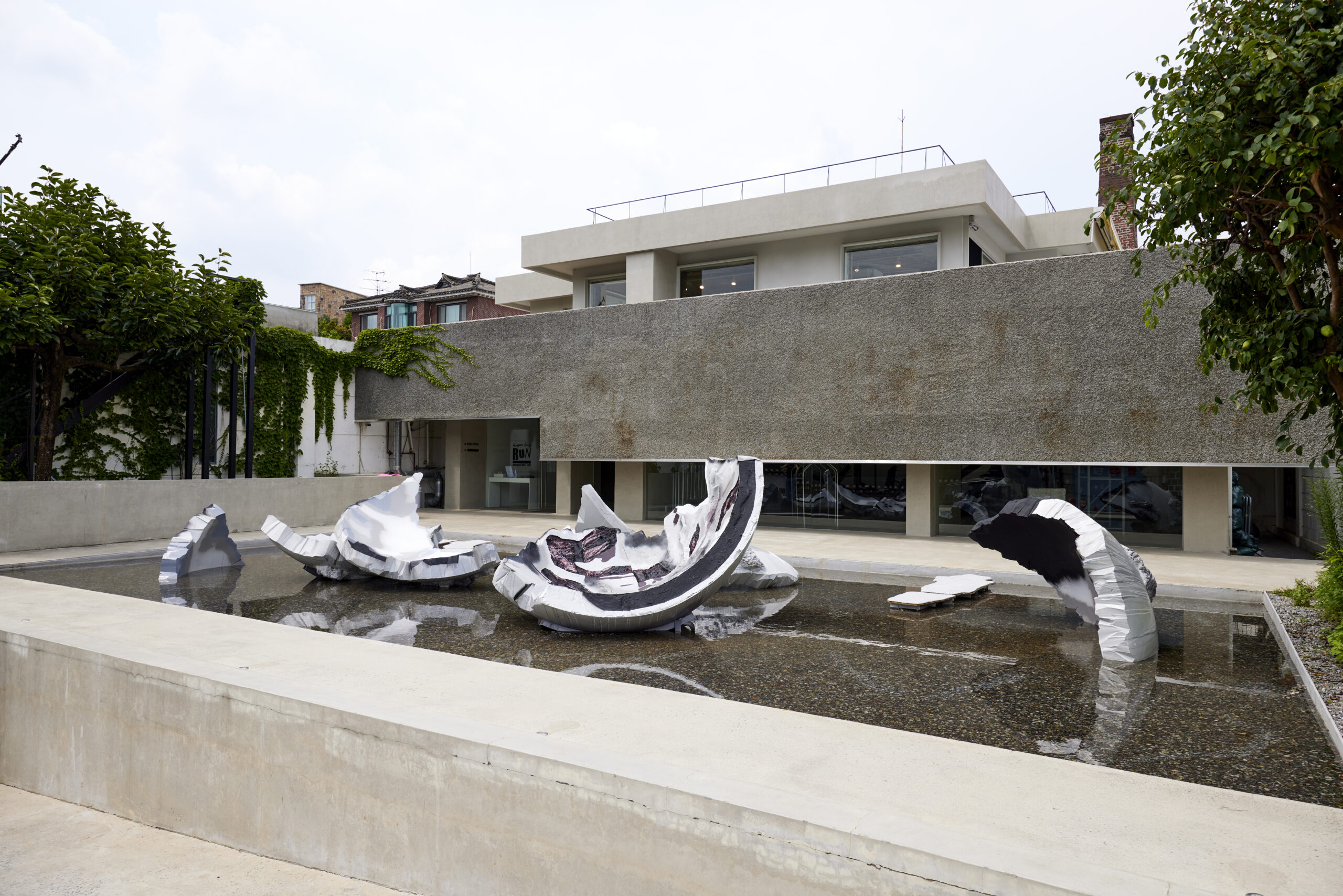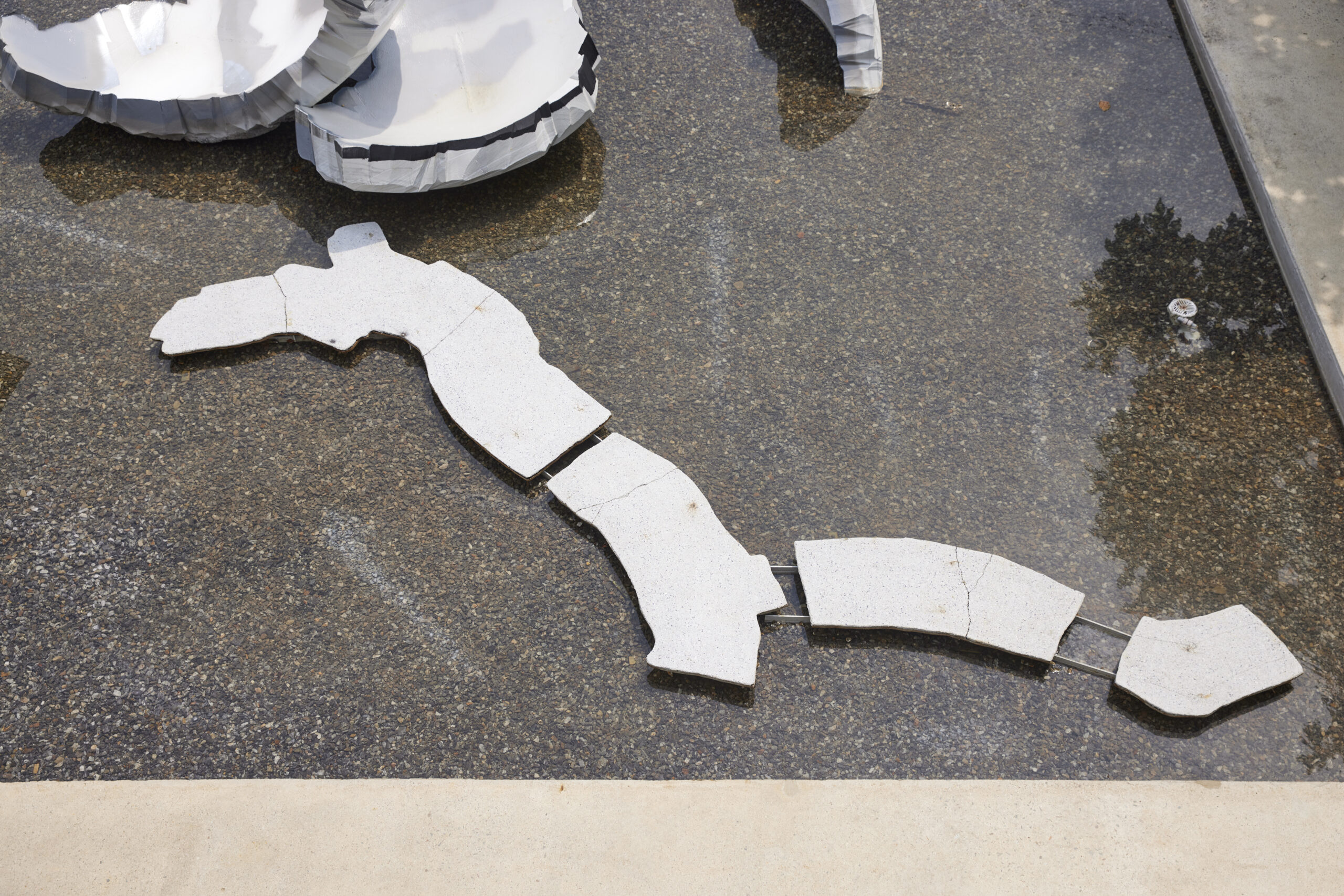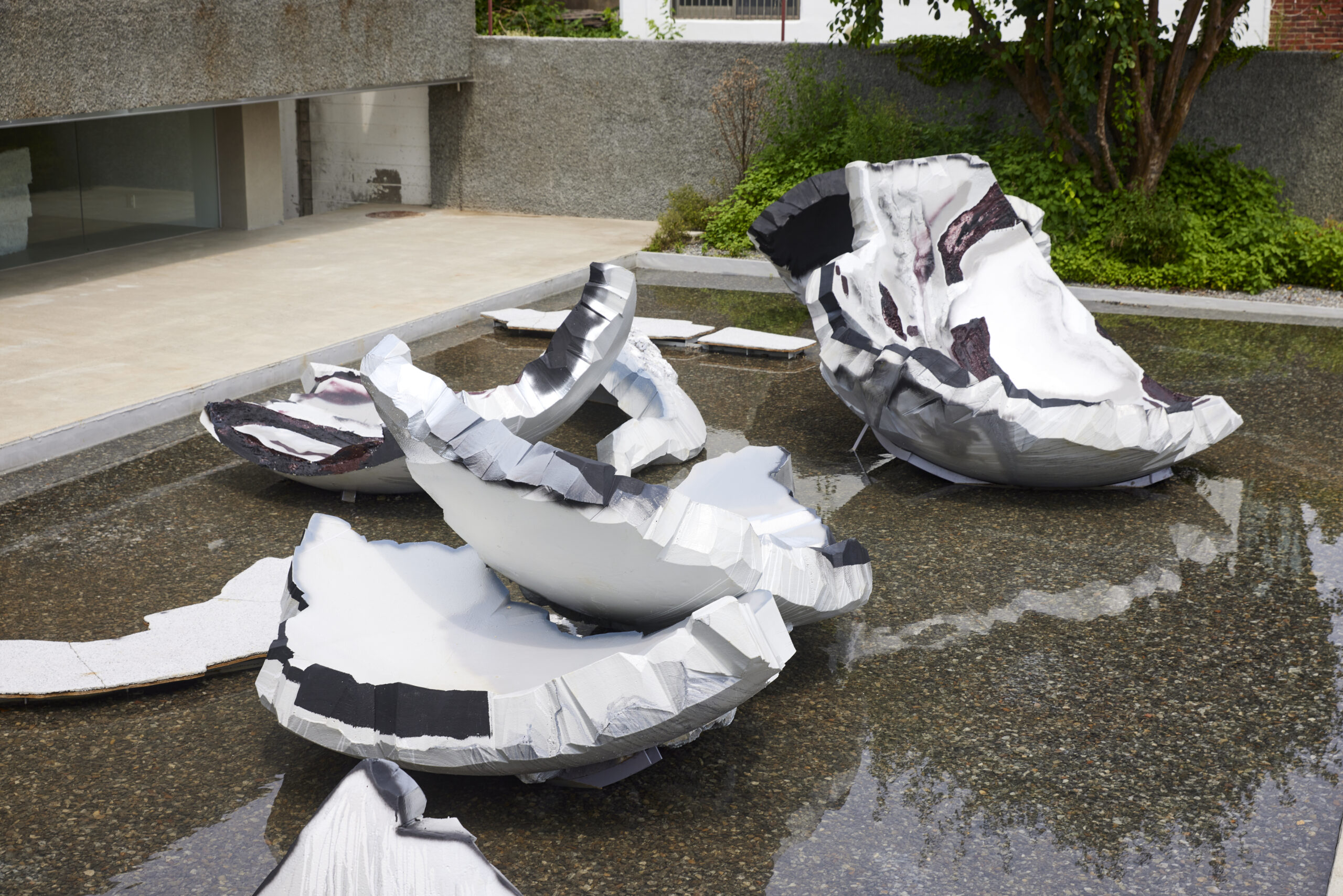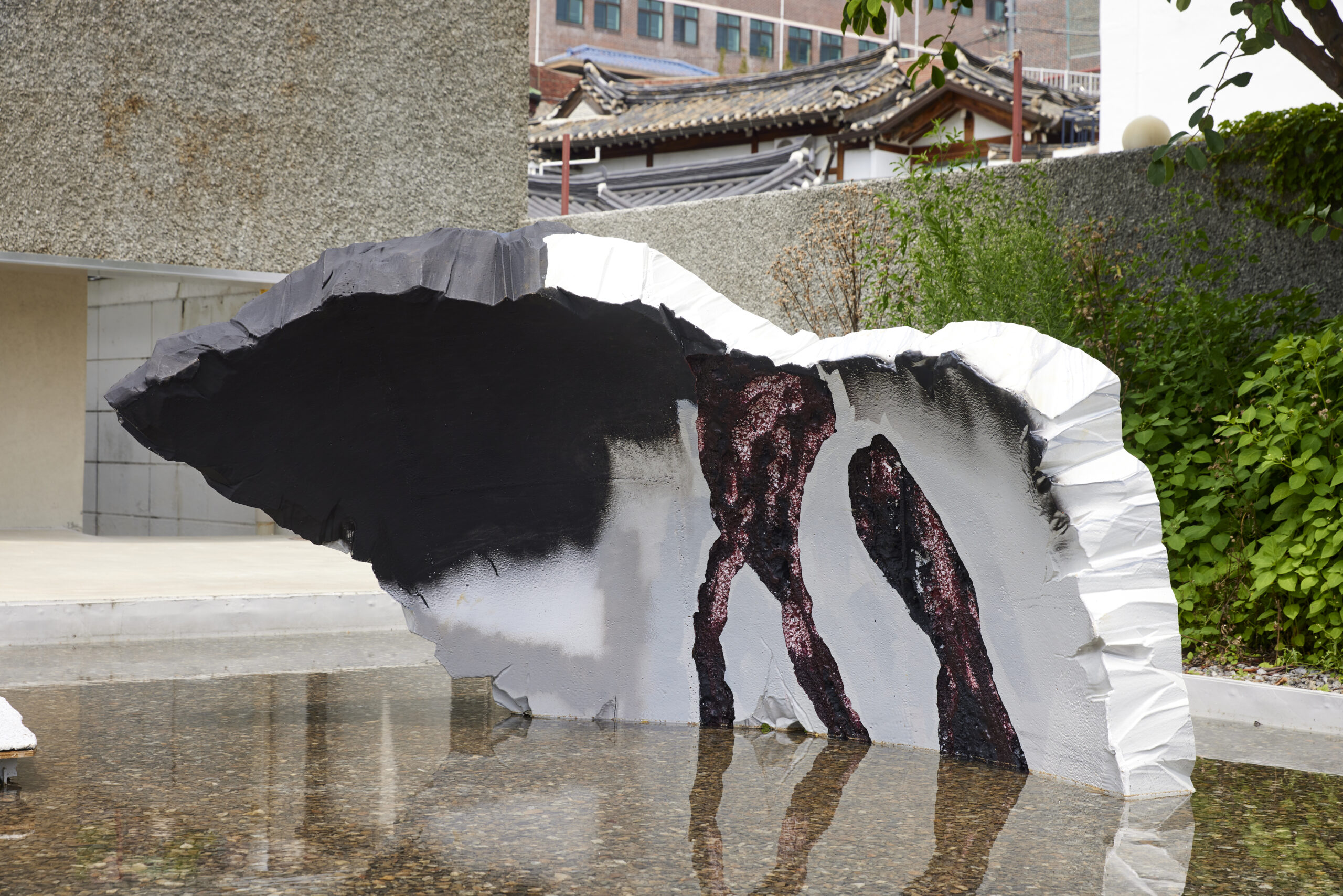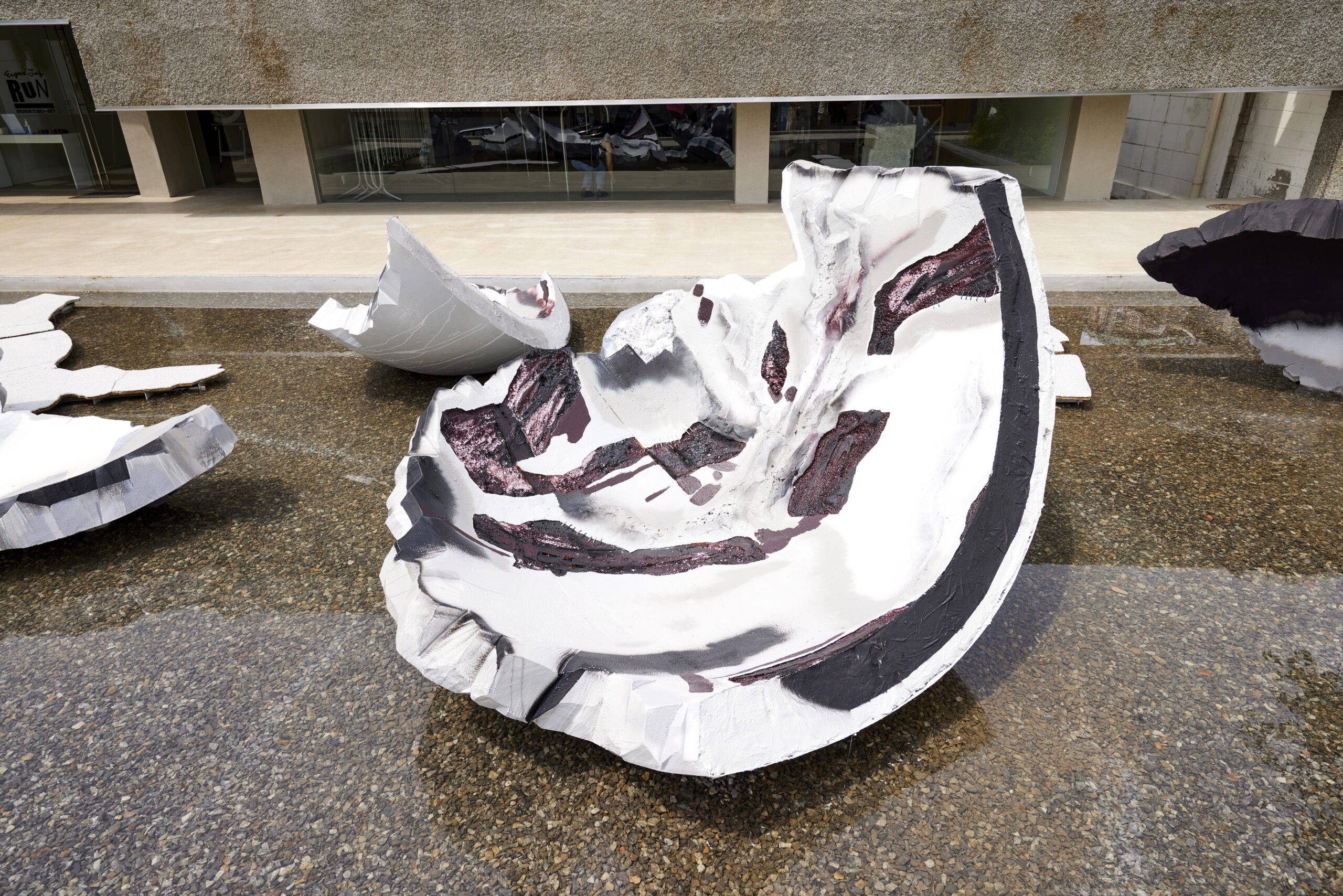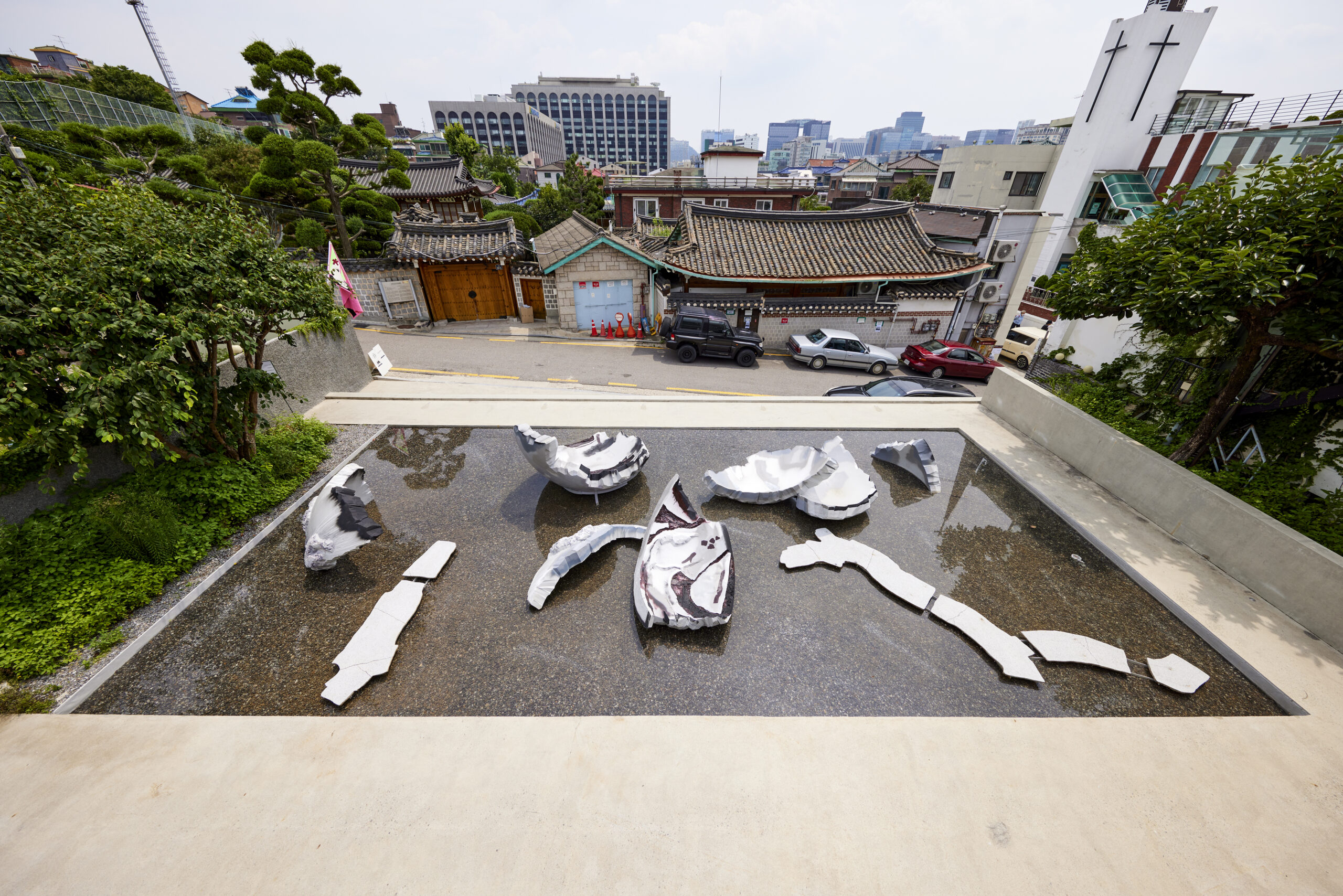《RUN》
정유진 개인전
2022.07.20.-09.07.
⠀
기획, 글 | 권혁규
그래픽 디자인 | 신신
그래픽 3D 애니메이션 | 강수민
진행 | 허호정
번역 | 말돼지
설치 | 장성진 신익균
도움 | 갈유라 김세은 엄지은 유소라 장유빈 정경빈 황호윤
주최 | 뮤지엄헤드
후원 | 서울시, 서울문화재단
《RUN》
Eugene Jung
20.JAN-07.SEP.2022.
Curating, Text | Hyukgue Kwon
Graphic Design | Shin Shin
Graphic 3D Animation | Soomin Kang
Curatorial Team | Hojeong Hur
Translation | Malpigg
Artwork Installation | Sungjin Jang, Ikkyun Shin
Thanks to Yu-ra Kal, Seeun Kim, Jieun Uhm, Sora Yu, Ubin Jang, Kyeongbin Jeong, Hoyoon Hwang
Hosted by Museumhead
Supported by Seoul, Seoul Foundation For Arts and Culture
You Better Run!
재난이 반복되는 일상이다. 전쟁, 바이러스, 지구온난화와 자연재해는 이제 뜻밖의 장소에서 일어나는 사고가 아니라 내가 속한 집단의 형편으로 자리한다. 일상 속 재난은 극복이나 돌파가 아닌 체념과 포기의 대상이 되고, 소비와 놀이에 더 가까워진다. 팬데믹 시기의 뉴노멀과 새 산업의 구호는 재난의 소비적 복제와 다름없어 보였다. 숫자로나마 존재하던 바이러스 확진자와 사망자는 데이터 그 이상도 이하도 아니게 됐으며, 누구의 관심도 끌지 못한 채 포털사이트 한편을 채운다. 도처에 나타나는 기후위기의 신호들은 누군가에게 영화 제목처럼, 별 볼 일 없는 삶을 위해 올려다보지 말아야(Don’t Look Up) 할 경고문일 뿐이다. 전쟁과 경제위기에도 블록체인과 가상화폐에 몰빵하며 달나라로의 이주를 망상할 수 있다면, 또 1인 캠핑과 무착륙비행패키지로 여행의 기분을 낼 수 있다면 별문제 없는, 심지어는 행복감을 느낄 수 있는 오늘이다. 사랑이 드라마를, 전쟁이 영화를 따라 하는 현재에, 재난의 복제와 소비는 더 이상 충격적이지도, 불온하지도 않은 따분한 일상 그 자체일지도 모르겠다.
온라인상에 짤로 존재하는, 외마디 비명 같은 “Run!(도망쳐!)”을 제목으로 택한 정유진 개인전 《RUN》(2022)은 모두의 것이 된 한편 현실감이 사라진 재난의 증후로부터 시작된다. 재난의 재현이 그 자체로 재앙인 오늘, 전시는 도처에서 발견되는 재난의 방관과 오독을 어떻게 등장시킬까. 먼저 제목이 고지하는 거리감을 말해보자. 무언가를 경험하고 이해(혹은 오독)하는 건 특정 이미지나 사물을 인지하는 것처럼 모종의 거리감 안에서 가능하다. 다시 말해, 거리감의 상실은 분리해서 인지할 수 있는 대상의 유실을, 나아가 경험의 부재를 의미한다. 작가는 지난 개인전 《해적판 미래 + 인간백해무익가든》(2019)을 통해 복사되고 배포되는 재난의 거주지를 추적했다. 그리고 재난과의 ‘거리감’이 원천적으로 봉쇄된 스펙터클과 오락이 감각과 경험의 무효화를 이끄는 장면을 목격케 했다. 그럼, 재난이 과거의 증언이나 미래의 예언이 아닌 날마다의 생활이 된 2022년, 《RUN》은 거리감이 조성되지 않은 세계로부터 어떤 도주, 혹은 생성을 탐색하게 될까. 전시는 지금 재난/일상의 몰입 불가능성에 어떻게 다가설까.
《RUN》은 일상적으로 발견되는 재난의 장면들을 조합하고 과장해 일종의 테마파크를 조성한다. 오늘 재난의 허구성을 실제 공간에 가설하며 수상함과 미심쩍음을 드러내는 것이다. 몇몇 작업을 살펴보면, 전시장 앞마당에 설치된 <Fortune earth>(2022)에서 작가는 주로 테마파크 입구에 자리하는 구 형태의 거대 지구 모형을 해체해 잔해처럼 늘어놓는다. 관객은 산산이 부서진 조각들에서 거칠게 박리되고 얽어매 흔적이 남은 내부, 갈라지고 절단된 단면, 울퉁불퉁한 표피층을 보게 된다. 이를 지나 전시장에 들어서면 녹슨 금속을 흉내 내는 얄팍한 벽을 마주한다. 가짜임을 전면에 드러내며 꿀렁거리는 벽 앞에는 벼락이 내려앉아 있고, 공간 안쪽에는 바리케이드가 줄지어 놓여있다. 제한과 통제의 물체들은 놀이기구 이용객을 위한 입장 안내선처럼 보이는 한편 코로나 19 임시선별진료소에 늘어선 대기 줄과 팬데믹에 중단된 행사들, 그 와중에 우격다짐으로 이어진 지난 대선 유세의 피로감을 상기시키기도 한다. 설치된 바리케이드 위로는 이전 작업에 등장했던 점쟁이문어의 일부가 정체불명의 생명체처럼 동그랗게 말려 전시장을 횡단, 부유한다. 이 밖에도 절단된 롤러코스터 구조물, 검문소 등에서 차량을 통제하거나 도주로를 차단하는 시설물, 재난의 이미지/드로잉이 들러붙은 아크릴 칸막이 등 각종 재난과 재해를 연상시키는 이미지와 물질들이 전시장에 혼재한다.
이처럼 전시는 위장된 물질/사물들로 다양한 재난의 시공을 교차시킨다. 마치 테마파크가, 가보지 못한 (혹은 갈 수 없는) 세계를 단숨에, 뻔뻔하게 재현해내듯 현실감 없는 재난의 경험을 즉물적으로 지시해낸다. 위 작업들은 물질의 빈약함과 조악함을 노골적으로 드러내는데, 상당수는 대량생산 유통되는 연약하고 임시적인 재료들로 만들어진다. 일례로 앞마당의 조각들은 스티로폼을 절단해 코팅, 채색한 결과이며, 차량 통제 구조물과 닮은 <****>(2022)은 두꺼운 종이에 메탈 느낌의 시트지를 붙이고 연출한 것이다. 군대 진지를 떠올리게 하는 <Dead End>(2022)은 해외 배송된 포대로 구축되고, <점쟁이 문어 말이>(2022)는 이전 작업 <점쟁이 문어 파울의 부활>(2019)을 재활용한다. 이들은 모두 어설프고 한시적인 위장술로 나타난다. 이는 해류병의 수신 불가능성과 재난을 병치시킨 코바야시 타이요와의 2인전 «해류병»(2021)에서처럼 재난의 복제성과 피상성을 물질화하려는 시도와 연결 지어볼 수 있다. 빈약한 이미지와 허술한 물질들은 재난의 가상성과 편재성을 주지시키지만, 그렇다고 일반화된 현재주의를 지적하거나 재난에 관한 특정한 정동을 증명하지는 않는다. 전시는 쾨쾨한 천장에서 태연자약하게 웃고 있는 <I•SMILE•U>(2022)처럼 진짜와 가짜, 부피와 납작함, 놀이와 재난, 잔혹함과 유치함의 신호를 여러 겹으로 얽고, 입체화한다.
나아가 작업은 영화나 만화, 게임에서 파악되는 이미지 생산의 대중화와 탈특권화를 모티브로 조각의 영원성과 기념비성을 상대화하기에 이른다. 기존 조각의 신화를 재연하는 일, 그리고 그것을 확장된 조각의 역사와 구조 안에 위치시키는 방법론은 적어도 이번 전시에서 주요 테제로 작동하지 않는다. 오히려 전시는 조각에 관습적으로 덧씌워진 오랜 재현의 논리와 영원성의 신화를 만화나 게임의 이미지 작동 방식에 포개 놓으며, 기존의 절대적, 보편적 질서에서 벗어나려 한다. 다시 말해, 가상성으로 넘쳐나는 재난의 경험과 언제든 재조립, 변형되는 조각/물질의 현재가 특정 대상을 허위로 복제하는 작가의 정형 행위에서 동시에 발견되는 것이다.
그럼 다시 처음 질문으로 돌아와, 조악한 테마파크로 등장해 도망치라고 외치는 전시가 가리키는 곳은 어디일까? 《RUN》이 현실감 없는 경험, 선취될 수 없는 현재를 물질화하는 이유는 무엇일까? 분명한 건 전시가 재난과 관련된 이미지와 사물을 실제 공간에 가상적으로 풀어놓으며 현재의 – 예술작품의 생산과도 직결되는 – 지배적인 지각 방식을 비유한다는 점이다. 여기서 테마파크의 작동원리라 할 수 있는, 텅 빈 기호의 파편들을 편집, 결합해 경험을 실제로부터 분리시키고 극적으로 무대화하는 과정은, ‘전시행위’와의 잠재적이며 복합적인 연관성 안에서 독해 가능하다. 같은 맥락에서, 경험 없는 지각이 무대화된 테마파크/전시가 일종의 경험/체험을 제시하는 점을 주요하게 언급할 수 있다. 관객은 공간 앞마당에 설치된 가짜 돌다리에 올라서고, 바리케이드가 만들어 놓은 동선에 따라 신체를 움직이게 된다. 또, 부활을 거듭하는 문어, 벽면과 천장에 안착해 있는 작업이 실제 공간의 외벽, 천장과 공생관계를 형성하고 있음을 체험적으로 확인한다. 이로써 전시는 팬데믹 이후 미심쩍어진 오프라인의 영역을, 그 안의 신체를 뻥튀기해낸다.
그렇다면 전시가 과장된 물질과 부피, 그리고 그것의 거짓말에 동참하는 신체를 강조하는 이유는 무엇일까. 작업이 제시하는 체험과 실제성은 지극히 집단적이고 대중적인 신체를 전제로 한다. 비밀스럽고 유일무이한 내면성이 도드라지는 감상과는 다른 일회적이고 동질적인 경험을 앞세우는 것이다. 집단화할 수 없는 연상에는 처음부터 관심이 없었던 전시는, 집단적 경험을 적극 수용하며 오늘 신체가 도달하지 않는 지점을 넌지시 드러낸다. 이처럼 현재의 사정이 자연스럽게 집약되길 실험하는 《RUN》은 재난과 미디어의 관계로 침투하고, 나아가 해방적 분출과 움직임을 상상하게 한다. 집단의 지각 방식과 행위를 옮겨오며, 보이는 것은 물론 보이지 않는 것까지 현시하고 사고하게 하는 일회적 사건을 도모하는 것이다. 개별 작업은 기존의 조각, 사물, 경험으로부터 이탈해 동시대 재난의 인지를 적극 복제한다. 더하여, 복제 대상과 관련된 모든 것이 전시될 수 있다는 믿음을 정언으로 삼으며, 일상이 된 디스토피아와 그 안의 집단적 신체를, 또 다른 움직임을 함께 그려보게 한다. 《RUN》의 과장된 복제물들은 그렇게 스펙터클 속에 사라진 재난과의 거리를 획득하는 도주의 출발점이 된다.
글 권혁규
You Better Run!
Disasters are recurring daily life. War, viruses, global warming, and natural disasters are no longer accidents in unexpected places but are present as the circumstance in the group I belong to. Disasters in everyday life become objects of resignation and abandonment rather than overcoming or breaking through, and they become closer to consumption and play. The slogan of the new normal and new industry during the pandemic was nothing less than a consumer replica of a disaster. The number of confirmed cases and deaths of the virus became nothing more than data and fills one side of portal sites without attracting anyone’s attention. The signs of the climate crisis that appear everywhere are just warnings to “Don’t Look Up” for your trivial life, as in the title of a movie. If you can fantasize about migrating to the moon while immersed in blockchain and cryptocurrency even in the face of war and economic crisis, and if you can fulfill your travel desires through single-person camping and no-landing flight package, there is no problem, you can even feel happiness despite everything. With love imitating tv dramas and wars imitating movies, the reproduction and consumption of disasters may be just boring daily life that is no longer shocking or disturbing.
Eugene Jung’s solo exhibition RUN (2022), which takes its title from an online meme, begins with the symptoms of a disaster that has become everyone’s but lost a sense of reality. Now when the representation of a disaster has become a disaster in itself, how will the exhibition address the neglect and misreading of disasters that are prevalent everywhere? First, let’s talk about the sense of distance the title indicates. Experiencing and understanding (or misreading) something Is possible within a certain sense of distance, just like perceiving an image or an object. In other words, the loss of sense of distance means the loss of an object that can be recognized as a separate entity, and furthermore, the absence of experience. The artist tracked the habitation of disasters copied and distributed through her last solo show Doomsday Garden + Pirated Future (2019). And the audience witnessed a scene where the spectacle and entertainment in which the ‘sense of distance’ from disasters was fundamentally blocked led to the invalidation of senses and experience. Then, in 2022, when disaster became a daily life, not a testimony of the past or prediction of the future, what kind of escape or creation will RUN explore from a world without a sense of distance? How does the exhibition approach the impossibility of immersion in disasters?
RUN creates a theme park of sorts by combining and exaggerating scenes of disasters found on a daily basis. The fictionality of today’s disaster is laid in the physical space, revealing suspiciousness and doubt. Through Fortune earth(2022), installed in the front yard of the exhibition space, the artist dismantles the giant sphere-shaped earth model, which is usually located at theme park entrances and arranges it like rubbles. The audience sees the roughly ripped off and entangled inside, cracked and cut cross-sections, and uneven surface layers from the shattered pieces. When the audience enters the space past this, they are faced with a thin sheet of walls that mimics rusted metal. Lightening lies in front of the undulating wall that is revealing its fakeness and barricades are lined up inside the space. The objects of restriction and control resemble entrance guidelines for theme park rides, while also reminiscent of long waiting lines at Covid-19 testing sites, other events suspended due to the pandemic, and the fatigue of the last presidential campaign which was enforced amid the pandemic. Above the installed barricades, parts of a fortune-telling octopus that appeared in Jung’s previous work are rolled up like an unidentified creature, crossing and floating across space. In addition, various images and materials reminiscent of disasters are jumbled in the space, such as cut-up roller coaster structures; facilities for controlling vehicles or blocking escape routes at checkpoints; and acrylic partitions with images/drawings of disasters. In this way, the exhibition intersects the time and space of various disasters with disguised materials/objects.
As the theme park at once and shamelessly recreates a world that one has never been to (or cannot go to), the exhibition immediately indicates the unrealistic experience of disasters. The above-mentioned works blatantly reveal its fragility and crudeness of materials, many of which are made of fragile and temporary materials that are mass-produced and distributed. For example, the shattered dome in the front yard is the result of cutting, coating, and coloring Styrofoam, and ****(2022), which resembles a vehicle control structure, is produced by attaching a metal-like sheet on a thick paper. Dead end(2022), reminiscent of a military camp, is built with sandbags shipped from overseas, and Psychic Octopus Roll(2022) reuses Resurrection of Paul the Psychic Octopus(2019). They all appear clumsy and temporary camouflage. This can be connected to the artist’s attempt to materialize the reproducibility and superficiality of disasters, as in the two-person show with Taiyo Kobayashi Drift Bottle(2021), which juxtaposed the impossibility of receiving drift bottles and disasters. The poor images and sloppy materials convey the virtuality and ubiquity of disasters, but they do not point to generalized presentism or prove a specific affect of disasters. Like I・SMILE・U(2022), which is smiling calmly on the musty ceiling, the exhibition intertwines and three-dimensionalizes the signs of real and fake, volume and flatness, play and disaster, cruelty and childishness in multiple layers.
Furthermore, the work reaches to relativize the eternity and monumentality of sculpture with the motif of the popularization and deprivatization of image production identified in movies, cartoons, and games. Re-enacting the myth of existing sculpture, and the methodology of placing it within the extended history and structure of sculpture does not work as a major thesis at least in this exhibition. Rather, the exhibition attempts to break away from the existing absolute and universal order by superimposing the long-standing logic of representation and the myth of eternity, which are customarily overlaid on sculpture, with the way images work in cartoons and games. In other words, the experience of disasters overflowing with virtuality and the present of sculpture/material that are reassembled and transformed at any time are simultaneously discovered in the artist’s practice of falsely replicating specific objects.
So back to the first question, where is this exhibition that appears as a crude theme park and shouts to run away pointing to? Why does RUN materialize the unrealistic experience and the present that cannot be preempted? What is clear is that the exhibition virtually reveals disaster-related images and objects in real space and compares the current – which is also directly related to the production of artwork – prevailing perception. Here, the process of editing and combining fragments of empty signifiers, isolating the experience from reality and staging it dramatically, which can be said to be the working principle of the theme park, can be read within the potential and complex connection with the ‘act of exhibiting’. In the same context, it can be pointed out that the theme park/exhibition in which perception without experience is staged presents a kind of experience. The audience climbs on a fake stone bridge installed in the front yard and moves their body according to the line created by the barricades. In addition, they empirically confirm that the octopus which is repeatedly revived and the work on the wall and ceiling form a symbiotic relationship with the outer wall and ceiling of the actual space. As a result, the exhibition opens up and exaggerates the offline realm which has been questionable since the pandemic, and the body within it.
Then, why does the exhibition emphasize the exaggerated material and volume and the body that participates in its lies? The experience and reality presented by the work presuppose an extremely collective and popular body. It puts forward a one-time, homogeneous experience that is different from the sentiment that is secretive, unique inner nature. The exhibition, which was not interested in associations that could not be grouped from the beginning, actively accepts collective experiences and hints at points where the body does not reach today. In this way, «RUN», which experiments to naturally aggregate the current situation, penetrates the relationship between disaster and media and further imagines liberating eruptions and movements. It aims to create a one-time event that shifts the collective perception and behavior and reveals and let us contemplate not only what is visible but also what is invisible. Individual works deviate from existing sculptures, objects, and experiences, actively replicating the perception of contemporary disasters. In addition, taking the belief that everything related to the object of replication can be exhibited as an absolute proposition, it lets us imagine the dystopian everyday, the collective body within it, and another movement with it. The exaggerated replicas of RUN become the starting point of escape to acquire the distance from the disaster that disappeared in the spectacle.
Hyukgue Kwon
translated by Malpigg

